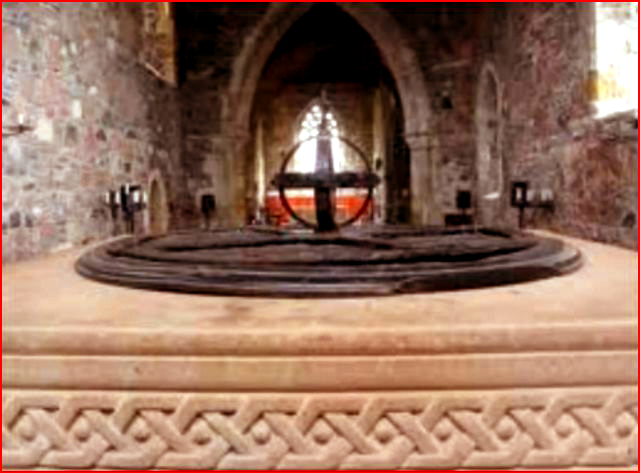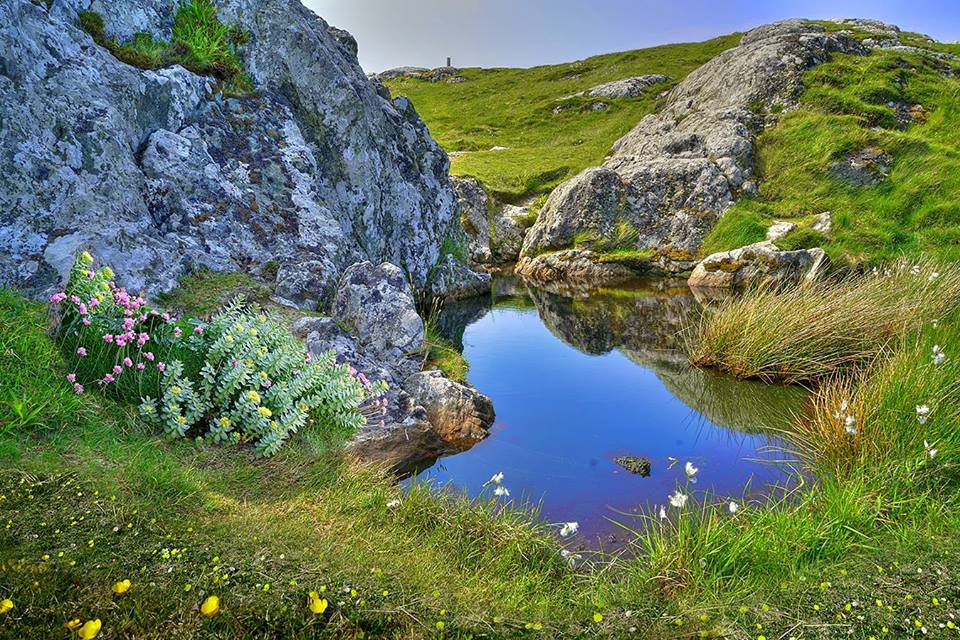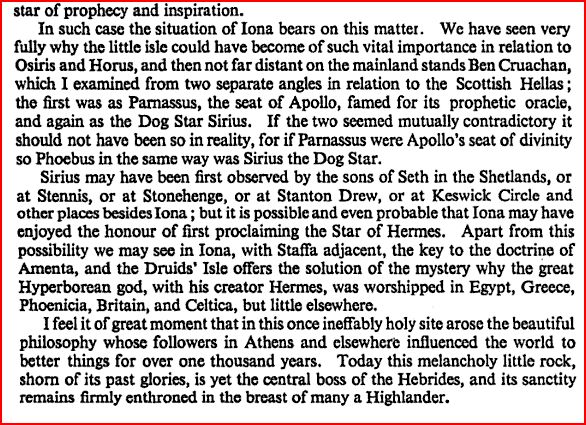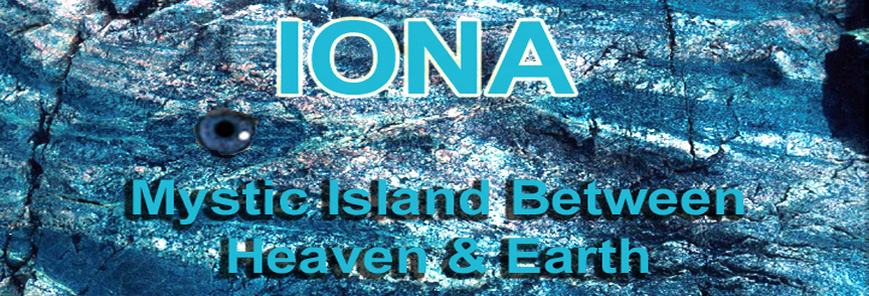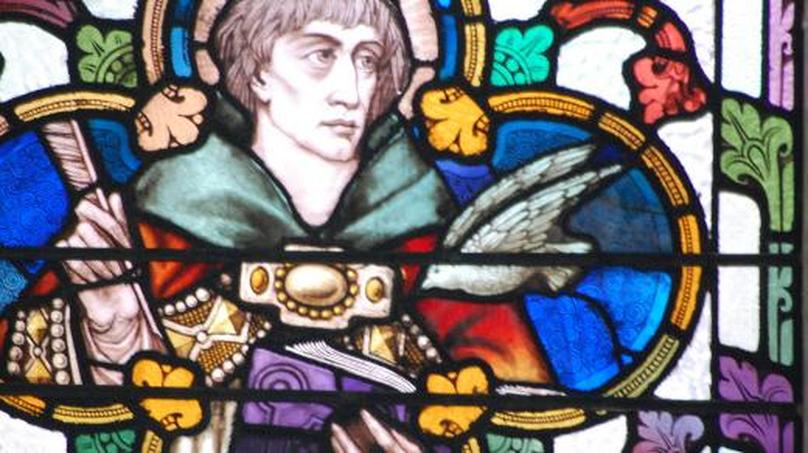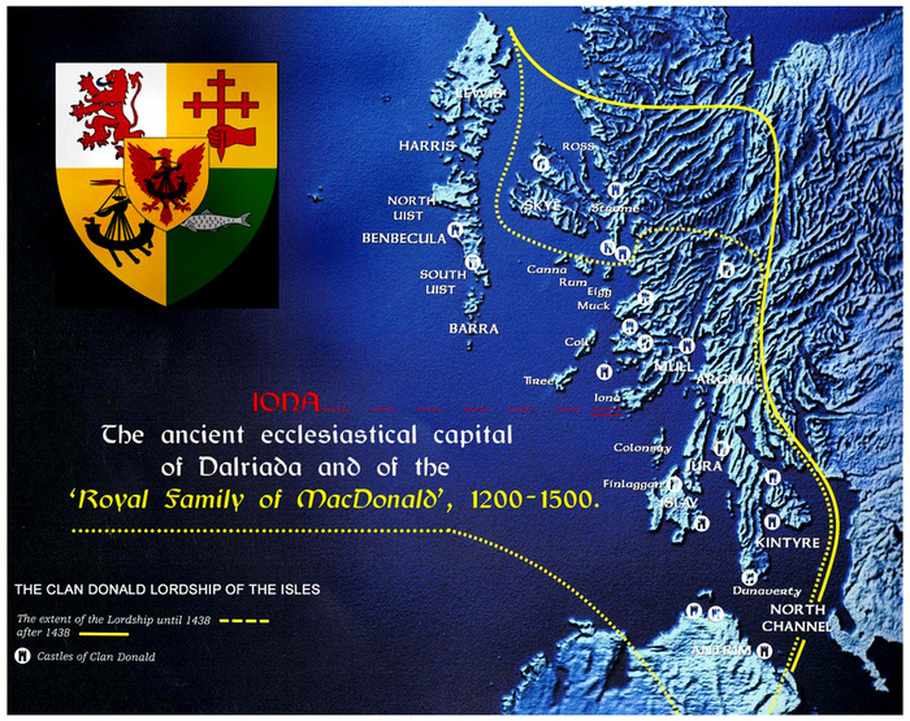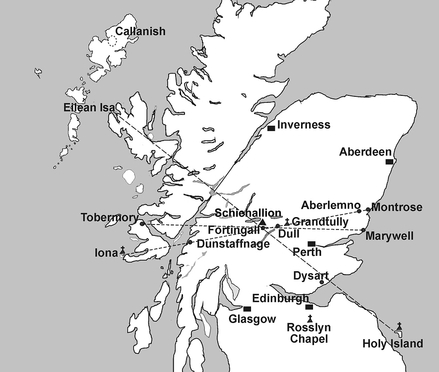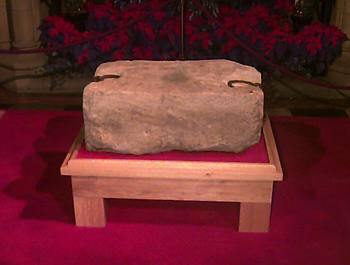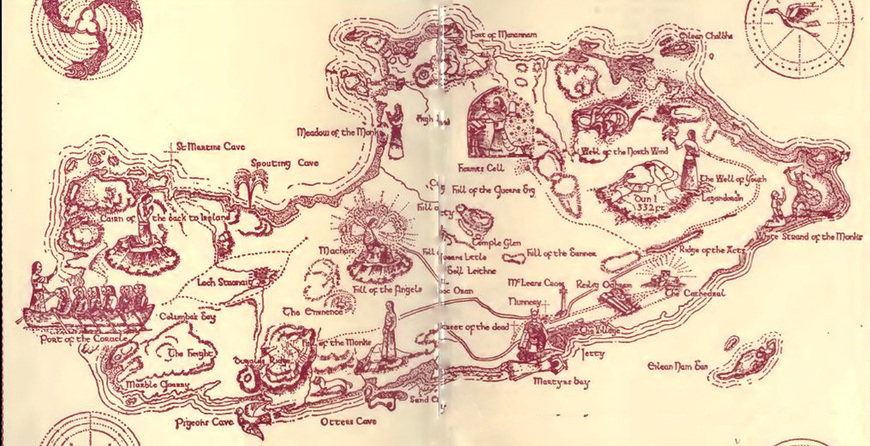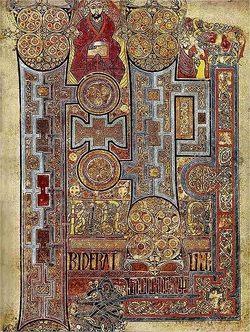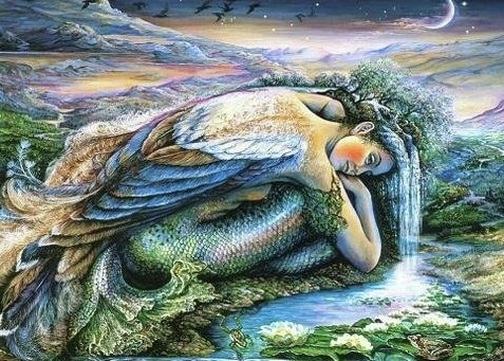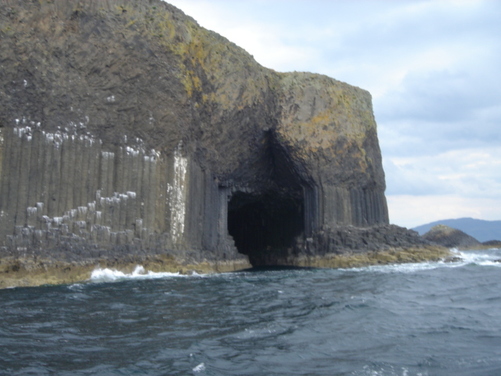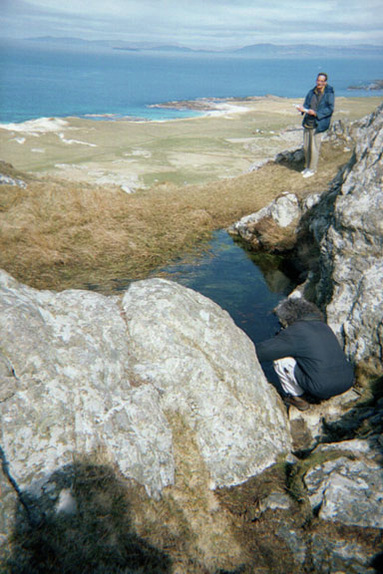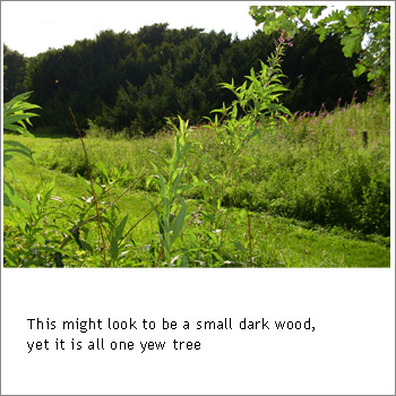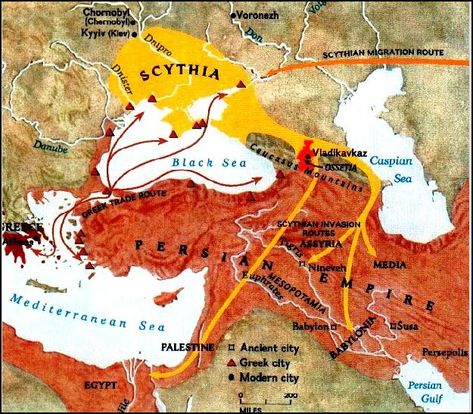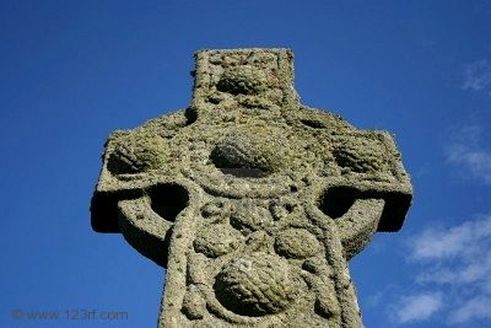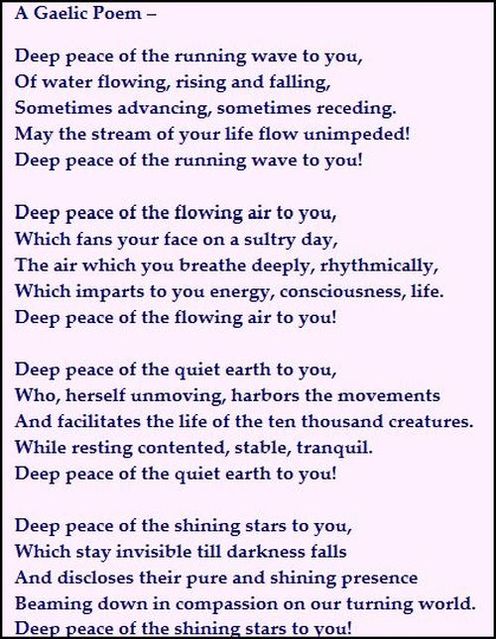IONA,
MYSTIC ISLAND of the DOVE
Metaphysical Ground Zero
by Iona Orr Miller, 2010
This article appeared in Green Egg Zine, #154, Yule 2010
There is a Celtic saying that heaven and earth are only three feet apart,
but in the thin places that distance is even smaller.
Hebrides means the Isles of the goddess Bride ... i.e., Sun Goddess BRIGID, aka BRIGHDE, BRIDE, BRIDEY, BRIGANTIA, BRITANNIA, who later became was incorporated into the Christian religion as the Christian Saint Bride. Iona is part of the Scottish Inner Hebrides - Isles of the goddess Bride.
Well of Eternal Youth, photo Michael Colin Campbell
Well of Eternal Youth, photo Michael Colin Campbell
http://books.google.com.pk/books?id=5-vCPBMTwEsC&printsec=frontcover&dq=comyns+beaumont&redir_esc=y#v=onepage&q=comyns%20beaumont&f=false
Deep peace of the running wave to you.
Deep peace of the flowing air to you.
Deep peace of the quiet earth to you.
Deep peace of the shining stars to you.
Deep peace of the infinite peace to you.
- Adapted from ancient Gaelic runes
Deep peace of the flowing air to you.
Deep peace of the quiet earth to you.
Deep peace of the shining stars to you.
Deep peace of the infinite peace to you.
- Adapted from ancient Gaelic runes
Isle of Iona
Constantine I, King of Alba b. 836, d. 877
(?), Donald I, King of Alba b. 812, d. 13 Apr 863
(?), Donald II, King of Alba d. 900
(?), Donald III 'Donald bane', King of Scotland b. c 1033, d. 1099
(?), Duncan I 'the Gracious', King of Alba b. c 1001, d. 14 Aug 1040
(?), Kenneth I 'the Hardy', King of Alba b. 810, d. 859
(?), Kenneth II, King of Alba d. 995
(?), Lulach 'the Fool', King of Alba b. c 1030, d. 17 Mar 1058
(?), Malcolm I, King of Alba b. c 897, d. 954
(?), Malcolm II, King of Alba b. c 954, d. 25 Nov 1034
Scotland, Macbeth, King of Scotland b. c 1005, d. 15 Aug 1057
Constantine I, King of Alba b. 836, d. 877
(?), Donald I, King of Alba b. 812, d. 13 Apr 863
(?), Donald II, King of Alba d. 900
(?), Donald III 'Donald bane', King of Scotland b. c 1033, d. 1099
(?), Duncan I 'the Gracious', King of Alba b. c 1001, d. 14 Aug 1040
(?), Kenneth I 'the Hardy', King of Alba b. 810, d. 859
(?), Kenneth II, King of Alba d. 995
(?), Lulach 'the Fool', King of Alba b. c 1030, d. 17 Mar 1058
(?), Malcolm I, King of Alba b. c 897, d. 954
(?), Malcolm II, King of Alba b. c 954, d. 25 Nov 1034
Scotland, Macbeth, King of Scotland b. c 1005, d. 15 Aug 1057
Dreamland At the Edge of the World
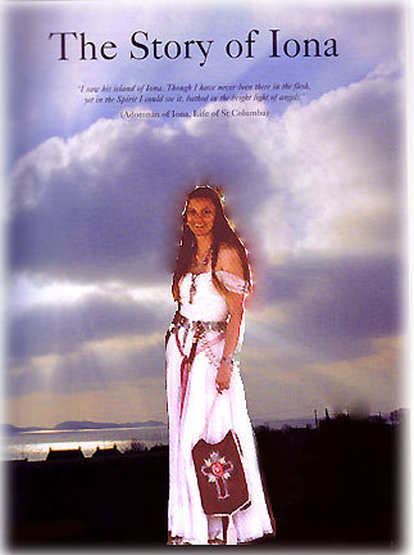
Y Gwir Erbyn Y Byd ("Truth Against the World”)
–Druid Motto
Divine Dreamland
Many holy sites are esteemed around the globe. The sacred isles of Britain have a spiritual role so rich that few comprehend their scope that is so disproportionate to their size. Sacred sites are natural meeting places of heaven and earth. A tiny, nearly barren speck of land, the Scottish island of Iona embodies an astounding holographic record of the span of human civilization, much of which is beyond the scope of this article. Each snippet of a hologram contains a smaller but intact version of the original image. The smallest parts of a hologram contain all the information possessed by the whole, demonstrating that separateness is an illusion. Cosmos is a superhologram, echoing the axiom, “As Above, So Below”.
The "whole in every part" nature of a hologram or fractal provides us with an entirely new way of understanding Iona which has been called “the Mecca of the Gael.” This mystic island was sacred to megalithic, iron and bronze age pagans, Druids and Celtic Christians alike. Windswept Iona is a time machine, a gem in the frigid sea, embedded in “the back of the ocean” like a planetary chakra.
Iona’s holy ground formed as the first oceans were condensing on the blistering hot surface of the earth. These rocks are so old, they contain no fossils. Perhaps the first plants took root in Iona’s thin soil. The island is the oldest rock on Earth, four billion year old remains of the Precambrian ocean’s eruptive spine. Her marble formed under vast heat and pressure. The metamorphic Lewisian gneiss shot through with green serpentine has resisted the relentless blue-foaming dragon of the devouring sea that eats up the land. Much of the island itself is highly-conductive and charged quartz, often said to enhance healing, telepathy, remote viewing, dreaming, and superconsciousness or store subtle information or energy. There are unseen things here that are eternal. From the mainland, the spiritually magnetic isle often appears like a mirage.
Iona is the “motherland of dreams”, the ethereal ground of imagination and ground zero of Druid culture. Its spell draws us into its center. Iona’s old Gaelic name Innis nan Druidhneach translates as the Island of the Druids. Their motto was Y Gwir Erbyn Y Byd (“Truth Against the World”). These Servants of Truth held greater power than the kings who took advice from them: All of nature was sacred to them and they were its students and stewards.
These seers and overlords understood the workings of Nature and our nature. To the male and female Druids and their predecessors, the “Shining Ones,” (Siddhe, Fairies), the dead live through visions in dreams, more so for those in one’s own lineage. In Druid lore myth is not plot, but image; not action, but rhythm; not character, but ghosts. Images animate the soul with guidance from higher dimensions. Alba or ‘light’ is the Gaelic name for Scotland and Iona is her most ancient and holy capital. The island Iona is the shape of a dove and curiously its name even means 'dove' in Hebrew, though it was named after the pioneering spirit, St. Columba, “the dove of the church”. The Rosarium Philosophorum equates the dove with heavenly light. Young visionaries, virginal children used as oracles or channels, are also called “Doves” in the magic tradition.
Sacred sites are like tuning forks. Iona’s colorful history is related to sea gods, King Arthur and Merlin, the Grail stories, St. Brighid and the Goddess -- Sophia, Virgin of the Light, the archetypal soror mystica. Its mystery and magic includes tales of Templars, elves, fairies, and pixies; the Sidhe or People of the Hills, Tuatha De Daanan. Angels’ Hill on Iona is associated with supernatural beings.
Iona was always an island of mystics and scholars. Iona’s most ancient Gaelic or Pictish name is Ioua. The name, (a corruption of early Gaelic Ii-shona, pronounced, Ee-hona; the 's' in Gaelic is silent before an aspirate), is steeped in multidimensional mystique that can be gradually unfolded in physical, emotional, mental, and spiritual metaphors. But it is more than a metaphor to be unraveled like a Scottish yarn. Indeed, an exciting and illuminating journey to the "heart of Iona" is a soulful initiatory journey into myth and eternity. Our journey does not have an ordinary aim.
The history and legends of Iona carry us into a vortex of the imagination, a time machine carrying us back through ages. To be a living soul is to live with imaginal images. Rather than linear, time is cyclic. There is a Celtic saying that heaven and earth are only three feet apart, but in the thin places that distance is even smaller, allowing Second Sight through the veil.These ‘thin places’ may be inter-dimensional portals, a natural combination of radiation and magnetism that produces altered states of consciousness or amplifies psychic ability. In Iona, time is no barrier, for it has been said of this ground zero of Druid tradition and ancient spirituality: “This island set apart, this motherland of many dreams, still yields its secret, but it is only as men seek that they truly find. “To reach the heart of Iona is to find something eternal,” (G.E. Troup).
Iona’s heart is the white marble that gave ancient Scotland the name Alba, or Albion (‘white’). Known for its ethereal light, Iona has been the destination of many epic spiritual journeys. The name of this magnetic “isle of dreams” has been called “a talisman of spiritual beauty.” In her enduring and silent way, Iona continues affecting the spiritual evolution of humanity, whispering her deepest secrets only to a few of her 250,000 annual visitors.
Even more make the astral journey to the “Iona of the heart.” The north of Iona is the traditional place of testing and ordeal, the south of work and labor, while the west is the place of mystic vision and the spirit. The east is the place of rebirth, compliment to the west as the realm of the dead.
–Druid Motto
Divine Dreamland
Many holy sites are esteemed around the globe. The sacred isles of Britain have a spiritual role so rich that few comprehend their scope that is so disproportionate to their size. Sacred sites are natural meeting places of heaven and earth. A tiny, nearly barren speck of land, the Scottish island of Iona embodies an astounding holographic record of the span of human civilization, much of which is beyond the scope of this article. Each snippet of a hologram contains a smaller but intact version of the original image. The smallest parts of a hologram contain all the information possessed by the whole, demonstrating that separateness is an illusion. Cosmos is a superhologram, echoing the axiom, “As Above, So Below”.
The "whole in every part" nature of a hologram or fractal provides us with an entirely new way of understanding Iona which has been called “the Mecca of the Gael.” This mystic island was sacred to megalithic, iron and bronze age pagans, Druids and Celtic Christians alike. Windswept Iona is a time machine, a gem in the frigid sea, embedded in “the back of the ocean” like a planetary chakra.
Iona’s holy ground formed as the first oceans were condensing on the blistering hot surface of the earth. These rocks are so old, they contain no fossils. Perhaps the first plants took root in Iona’s thin soil. The island is the oldest rock on Earth, four billion year old remains of the Precambrian ocean’s eruptive spine. Her marble formed under vast heat and pressure. The metamorphic Lewisian gneiss shot through with green serpentine has resisted the relentless blue-foaming dragon of the devouring sea that eats up the land. Much of the island itself is highly-conductive and charged quartz, often said to enhance healing, telepathy, remote viewing, dreaming, and superconsciousness or store subtle information or energy. There are unseen things here that are eternal. From the mainland, the spiritually magnetic isle often appears like a mirage.
Iona is the “motherland of dreams”, the ethereal ground of imagination and ground zero of Druid culture. Its spell draws us into its center. Iona’s old Gaelic name Innis nan Druidhneach translates as the Island of the Druids. Their motto was Y Gwir Erbyn Y Byd (“Truth Against the World”). These Servants of Truth held greater power than the kings who took advice from them: All of nature was sacred to them and they were its students and stewards.
These seers and overlords understood the workings of Nature and our nature. To the male and female Druids and their predecessors, the “Shining Ones,” (Siddhe, Fairies), the dead live through visions in dreams, more so for those in one’s own lineage. In Druid lore myth is not plot, but image; not action, but rhythm; not character, but ghosts. Images animate the soul with guidance from higher dimensions. Alba or ‘light’ is the Gaelic name for Scotland and Iona is her most ancient and holy capital. The island Iona is the shape of a dove and curiously its name even means 'dove' in Hebrew, though it was named after the pioneering spirit, St. Columba, “the dove of the church”. The Rosarium Philosophorum equates the dove with heavenly light. Young visionaries, virginal children used as oracles or channels, are also called “Doves” in the magic tradition.
Sacred sites are like tuning forks. Iona’s colorful history is related to sea gods, King Arthur and Merlin, the Grail stories, St. Brighid and the Goddess -- Sophia, Virgin of the Light, the archetypal soror mystica. Its mystery and magic includes tales of Templars, elves, fairies, and pixies; the Sidhe or People of the Hills, Tuatha De Daanan. Angels’ Hill on Iona is associated with supernatural beings.
Iona was always an island of mystics and scholars. Iona’s most ancient Gaelic or Pictish name is Ioua. The name, (a corruption of early Gaelic Ii-shona, pronounced, Ee-hona; the 's' in Gaelic is silent before an aspirate), is steeped in multidimensional mystique that can be gradually unfolded in physical, emotional, mental, and spiritual metaphors. But it is more than a metaphor to be unraveled like a Scottish yarn. Indeed, an exciting and illuminating journey to the "heart of Iona" is a soulful initiatory journey into myth and eternity. Our journey does not have an ordinary aim.
The history and legends of Iona carry us into a vortex of the imagination, a time machine carrying us back through ages. To be a living soul is to live with imaginal images. Rather than linear, time is cyclic. There is a Celtic saying that heaven and earth are only three feet apart, but in the thin places that distance is even smaller, allowing Second Sight through the veil.These ‘thin places’ may be inter-dimensional portals, a natural combination of radiation and magnetism that produces altered states of consciousness or amplifies psychic ability. In Iona, time is no barrier, for it has been said of this ground zero of Druid tradition and ancient spirituality: “This island set apart, this motherland of many dreams, still yields its secret, but it is only as men seek that they truly find. “To reach the heart of Iona is to find something eternal,” (G.E. Troup).
Iona’s heart is the white marble that gave ancient Scotland the name Alba, or Albion (‘white’). Known for its ethereal light, Iona has been the destination of many epic spiritual journeys. The name of this magnetic “isle of dreams” has been called “a talisman of spiritual beauty.” In her enduring and silent way, Iona continues affecting the spiritual evolution of humanity, whispering her deepest secrets only to a few of her 250,000 annual visitors.
Even more make the astral journey to the “Iona of the heart.” The north of Iona is the traditional place of testing and ordeal, the south of work and labor, while the west is the place of mystic vision and the spirit. The east is the place of rebirth, compliment to the west as the realm of the dead.
Sacred Pentagram of Scotland
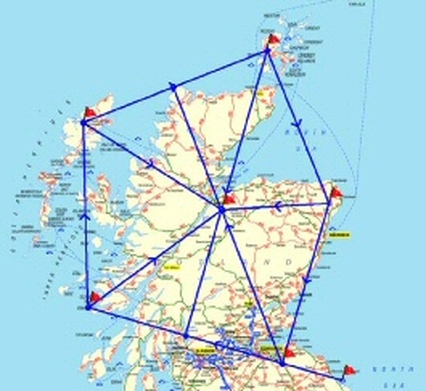
On Iona, vivid moments of focused experience are interspersed with those of emptiness. Magic happens in those gaps between breaths and waves when you attune with the singing wind and ringing stones. Iona’s highest hill, Dûn-I (Doon-ee), an iron-age fortress, hides a little pool amid the broken rocks and heather near the beehive cairn that marks the highest part of the island. From there you can also see the Cairn of the Back to Ireland. Sliav Starr (The Hill of Noises) faces the westernmost part of the island, Port-na-Churaich (The Haven of the Coracle) where St. Columba was said to have first landed on Iona.
Early Ogham inscriptions referred to the island as Ioua, after a Moon goddess, but other early sources said it was HyBrasil (Island of Beauty or Worth), or simply Hy, an earthly paradise found far out at sea, or perhaps a reference to the otherworldly Tir na nOg (the Land of Youths or the Ever-Young). Druid maps listed Iona as Innis nan Druidnean (or Innis na Druineach), the Isle of Druids, possibly because it is believed that at one time the island was covered with oak and yew trees, sacred to the Druids, and had 350 standing stones, megalithic structures frequented by Druids.
There are rocking stones in Iona called na clachan-bràth, within the precincts of a burial ground, placed on the pedestal of a cross. Some call them tomb supports, but finely-balanced rocking stone were used in trials. A clach-bràth is sometimes known as a judgment stone. The reason that courts were near "logan" stones is that the movement of stones in such formations was used to determine the guilt or innocence of those accused of serious crimes in ancient times. Druids used them to judge people. The accused was made to sit on the stone and by the way it moved the Druids judged the innocence or guilt of the individual.
Near to the Tormore pier and above the sandy cove, hidden amongst the rocks is a cave called "The Cave of the Dead", (Uamh na Marbh) large enough in size to hold a coffin containing an ancient Scot's king. Was it a perfect place to shelter in bad weather for the final journey of burial to Iona or a Druid initiation in Fingal's Cave? Imagine the awe of approaching such a natural wonder in times long past. In the Lord of the Isles, Sir Walter Scott beautifully contrasts the church on Iona with the cave of Staffa, opposite -
"Nature herself, it seemed, would raise
A minster to her Maker's praise!
Not for a meaner use ascend
Her columns, or her arches bend;
Nor of a theme less solemn tells
That mighty surge that ebbs and swells,
And still between each awful pause,
From the high vault an answer draws,
In varied tone, prolonged and high,
That mocks the organ's melody;
Nor doth its entrance front in vain
To old Iona's holy fane,
That Nature's voice might seem to say,
Well hast thou done, frail child of clay
Thy humble powers that stately shrine
Tasked high and hard - but witness mine."
Early Ogham inscriptions referred to the island as Ioua, after a Moon goddess, but other early sources said it was HyBrasil (Island of Beauty or Worth), or simply Hy, an earthly paradise found far out at sea, or perhaps a reference to the otherworldly Tir na nOg (the Land of Youths or the Ever-Young). Druid maps listed Iona as Innis nan Druidnean (or Innis na Druineach), the Isle of Druids, possibly because it is believed that at one time the island was covered with oak and yew trees, sacred to the Druids, and had 350 standing stones, megalithic structures frequented by Druids.
There are rocking stones in Iona called na clachan-bràth, within the precincts of a burial ground, placed on the pedestal of a cross. Some call them tomb supports, but finely-balanced rocking stone were used in trials. A clach-bràth is sometimes known as a judgment stone. The reason that courts were near "logan" stones is that the movement of stones in such formations was used to determine the guilt or innocence of those accused of serious crimes in ancient times. Druids used them to judge people. The accused was made to sit on the stone and by the way it moved the Druids judged the innocence or guilt of the individual.
Near to the Tormore pier and above the sandy cove, hidden amongst the rocks is a cave called "The Cave of the Dead", (Uamh na Marbh) large enough in size to hold a coffin containing an ancient Scot's king. Was it a perfect place to shelter in bad weather for the final journey of burial to Iona or a Druid initiation in Fingal's Cave? Imagine the awe of approaching such a natural wonder in times long past. In the Lord of the Isles, Sir Walter Scott beautifully contrasts the church on Iona with the cave of Staffa, opposite -
"Nature herself, it seemed, would raise
A minster to her Maker's praise!
Not for a meaner use ascend
Her columns, or her arches bend;
Nor of a theme less solemn tells
That mighty surge that ebbs and swells,
And still between each awful pause,
From the high vault an answer draws,
In varied tone, prolonged and high,
That mocks the organ's melody;
Nor doth its entrance front in vain
To old Iona's holy fane,
That Nature's voice might seem to say,
Well hast thou done, frail child of clay
Thy humble powers that stately shrine
Tasked high and hard - but witness mine."
Folklore
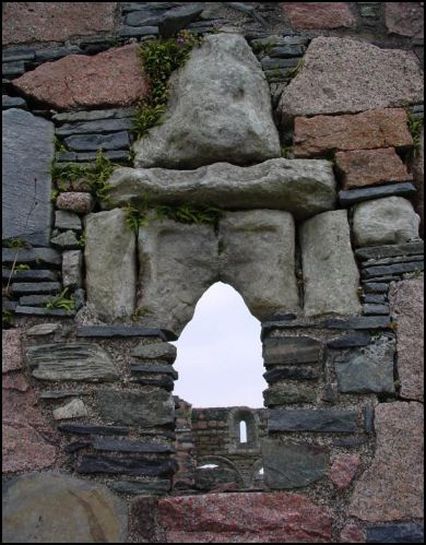
The Druidical system peaked at the time of the Roman invasion under Julius Caesar. Against the Druids, as their chief enemies, these conquerors of the world directed their unsparing fury. The Druids, harassed at all points on the main land, retreated to Anglesey and Iona, where for a
season they found shelter and continued their sacred rites.
The Druids retained their predominance in Iona and over the adjacent islands and main land until they were supplanted and their traditions and culture overturned by the arrival of St. Columba, the apostle of the Highlands, in 563 AD.
Sheela-na-Gigs are directly related to earlier Goddess/Fertility figurines and the Goddess symbolism of the early pre-historic and Celtic periods. It is not certain how old the tradition is or the precise age of some of the earliest examples. Apparently, the Sheela-na-Gig made its appearance during the latter part of the Early Christian (or Celtic Christian) period and they were still being erected during the later Middle Ages. There is one built into the wall of the Nunnery on Iona.
Sheela-na-Gigs are religious carvings of women, special women, the symbolical representation of femininity and/or actual female deities or Goddesses. They were placed on churches, castles and other important buildings of the medieval period and, until quite recently in some instances, they acted as dedicatory or protective symbols promoting good luck and fertility. But their meaning goes much deeper and the fact that they were erected over the doorways of churches and castles and otherwise placed in very prominent positions suggests that they were a very potent and powerful image, obviously the primary religious belief of the people of that era of Christianity. Sheela-na-Gigs are directly related to earlier Goddess/Fertility figurines and the Goddess symbolism of the early pre-historic and Celtic periods.
Like many of the ancient Celtic goddesses, Cailleach had two faces: dark and light. In the winter months she was fearsome, whirling around Scotland with her nine hag-servants, casting storm, snow, and ice over the land. But in springtime, she renewed herself in the Well of Youth on the isle of Iona, and was transformed into the beautiful spring maiden, Bridget or Bride, who brought back light and warmth to her people again. She also appeared at this time of the year, called Lùnasdal in Scotland, Lughnasa in Ireland, as the personification of the ripe sheaves of oats or barley that would feed the clans at harvest time.
From the hilltop Dun-I of Iona with its sacred well, St. Bride sang daily to her lost Bridegroom. St. Bride of the Kindly Fire, St Bride of the Shores. Before she was Christianized as a saint, Brighde or Bride was already present on Iona as Goddess. Her totems were the swan and the serpent. Many generations have drunk from and ritually purified themselves in this holy healing pool called Tobar na h’oige, “the Fountain of Youth,” or “Well of Youth,” in which the dark Goddess annually renews herself for her light phase. There are energetic alignments or grids of holy islands, holy mountains and holy wells in Scotland.
Iona is a geomantic power site – a vortex. Anchoring a pentagonal matrix of ley lines, (invisible currents of earth-energy), enchanting Iona is a gateway to the Other World. This telluric intersection of three ley lines lies in a swampy part of the island, marked by low lying boulders in a perfect circle with a central altar stone. Iona’s leyline alignment extends to Montrose on the east coast of the Scottish mainland, passing through the ancient Celtic royal burial site at Dunstaffnage, then Fortingall, St. Mary’s Church, Grandtully, Aberlemno, which is marked by two ancient and inscribed stones, finally reaching Montrose (Mount of the Rose).
Precambrian Crystalline Basement
The ancient deeply bedded Lewisian Gneiss rock strata, such as that found on Iona, is rarely exposed at the surface of the planet. Ancient imbedded strata is metamorphicly altered, compacted. The enormous pressure transforms the composition of the rock to a more ordered, crystalline structure. All crystalline structures have an electromagnetic field. The greater the density, the stronger the field. The aura of balance and peace that blankets Iona is in part due to the unique qualities of this ancient metamorphic stone, the granitic Lewisian Gneiss. In addition, the strata upthrust and sharp hairpin fold of earth layer that peels the Lewisian Gneiss onto the surface also results in a magnetic energy release that 'thins the veil' between planes. Science has documented the relationship between magnetic anomalies and psychic phenomena and experiences.
An RAF pilot told a Scots freemason that every time they flew over Iona the compass would completely spin around and be useless. That suggests that the island itself had unusual geomagnetic properties. Since the druids were very aware of Earth energies it would be logical to assume that they knew about Iona, long before Columba went there with his pilgrim monks in the sixth century.
There is a remarkable geological difference on Iona from the Island of Mull, a mere two miles across the Iona Sound. The Island of Iona is a rare upthrust of one of the oldest rock formation on earth. The 2900 million year old Lewisian granitic Gneiss dominates three quarters of the island. (The earth is approximated at 4,400 million years old). Mull is dominated by a relatively young, 300 million-year-old pink granite formation. This is in part an explanation for the differentiating vibration that led both Druids and St. Columba to recognize Iona (and not Mull), as a sacred place for worship.
Such pilgrimage sites around the world have geophysical connection. You definitely feel different in such places. The local energy seems highly conducive to connecting with deeper levels of oneself and the universe. The Druids occupied Iona and used nearby Staffa Island (known for its massive crystallized pillars of hexagonal basalt) as a point of mystical initiation rites for high priests. The whole system is a magnetic anomaly.
Staffa Island is in itself a unique and very powerful energy center. Staffa is a temple, a pulsing generator of white crystalline energy, charging all around it. Staffa energizes and protects Iona, and is a key benefactor of Iona's vibrational quality. The varying lengths of hexagonal crystalline basalt pillars are like musically tuned windpipes on a massive organ creating a pure symphonic frequency, (in concert with all 7 chakras). Its generated energy is musical, crystalline, and penetrating. It energizes and effects the area like an enormous Tibetan bell. It charges and vitalizes the sea. A visit to Iona, by any seeker, requires a visit to Staffa, and especially Fingals cave.
Fingals is a pillared sea cave on Staffa, running 227 feet in length, approximately 75 feet wide with a tapered roof, and curved pipe pillars extending 100 feet high. Its symmetry is stunning, and remarkably shaped liked inside of a great cathedral, complete with buttresses. The Druids only entered Fingals Cave for initiate rites of the highest order. Geomagnetic resonance effects create a deep sense of peace, or a feeling of "being home". Pilgrims from all over the world come to Iona.
The metamorphic nature of the granitic Lewisian Gneiss, combined with earth fold magnetic fields creates a crystalline lattice energy that is very dense, and acts as a receptor to the charged harmonic projections emitted from Staffa. These energy frequencies that bombard Iona segregate in certain pockets into resonant frequencies that correlate to pure musical notes, and to the chakras. The points on Iona resonate with chakra centers.
These are:
Dun I Mound (Cairn on Top) - Crown (Seventh) Chakra, Note B#
Gneiss Slab ( 12 ' x 6 foot) ( In field on immediate north side of Abbey) - Third Eye (Sixth) Chakra, Note A
Signal Hill - Throat (Fifth) Chakra, Note G#
Angel Hill - Heart ( Fourth) Chakr, Note F#
Hill of Lambs - Emotional (Third) Chakra, Note E
Back to Ireland Cairn - Creative (Second) Chakra, Note D#
Columba Bay (Standing Rock just before the beach) - Base (Root) Chakra, Note C
The crown vortex is centered on the stone cairn atop Dun I, the highest point on the island, just behind the and to the north of the Abbey. The Dun I Mound is absolutely the strongest energy point on Iona. It is a fifteen-minute hike to reach the top, up somewhat slippery trails. The reward is immediate. The visionaries say an angelic being hovers atop the mound and anchors the portal that radiates joyous love energy into the site. The Dun I Mound itself spirals sacred earth energy in a fountaining cascade atop the mound. Dun I is a place of emergence, clearing and vision. All seven chakras are tuned and healed in this area.
Pre-Christian Ionians worshipped the Mother Goddess, sister of the sun god Bel, also worshipped in Egypt and Asia Minor. Her sites are associated with sacred springs, fountains and wells. This Mother Church connects the Gaels with the cradles of civilization in Europe and Asia. Iona used to have a circle of standing stones and there are remains of over 350 megalithic stones. One site is called The Glen of the Temple, another, the Tabernacle of Culdees. The Culdees, remnants of the Druids, practiced hereditary descent and wore white robes like the Druids. Some of Iona’s megaliths may have been carved into the numerous Celtic crosses of the island, some of which have gone missing. Both Druids and Culdees were called “certain strangers.” The term changed over centuries to Coli Dei, “servants of the Lord,” used for the Celtic Christian monks that worshiped on the island beginning in the 6th century.
Each footfall on Iona activates spontaneous “memories”, unconscious stirrings. Life is “sung with ecstatic serenity.” It resonates with the deep past as the ground of our being. The swirling ocean echoes the sounding of our unconscious. Legends of magical caves reflect images of the potentially luminous caverns of our heads. Iona is a place of sanctuary, healing, visions and prophecy. If she touches you with Fairy Ointment, thereafter, all the world and its inhabitants look beautiful. Each of us unravels the story for ourselves. It is a journey through the labyrinth of history and mystery. There are too many threads to follow in one short article, but a quick search of any of these rewarding keywords + Iona can fill in the blanks.
season they found shelter and continued their sacred rites.
The Druids retained their predominance in Iona and over the adjacent islands and main land until they were supplanted and their traditions and culture overturned by the arrival of St. Columba, the apostle of the Highlands, in 563 AD.
Sheela-na-Gigs are directly related to earlier Goddess/Fertility figurines and the Goddess symbolism of the early pre-historic and Celtic periods. It is not certain how old the tradition is or the precise age of some of the earliest examples. Apparently, the Sheela-na-Gig made its appearance during the latter part of the Early Christian (or Celtic Christian) period and they were still being erected during the later Middle Ages. There is one built into the wall of the Nunnery on Iona.
Sheela-na-Gigs are religious carvings of women, special women, the symbolical representation of femininity and/or actual female deities or Goddesses. They were placed on churches, castles and other important buildings of the medieval period and, until quite recently in some instances, they acted as dedicatory or protective symbols promoting good luck and fertility. But their meaning goes much deeper and the fact that they were erected over the doorways of churches and castles and otherwise placed in very prominent positions suggests that they were a very potent and powerful image, obviously the primary religious belief of the people of that era of Christianity. Sheela-na-Gigs are directly related to earlier Goddess/Fertility figurines and the Goddess symbolism of the early pre-historic and Celtic periods.
Like many of the ancient Celtic goddesses, Cailleach had two faces: dark and light. In the winter months she was fearsome, whirling around Scotland with her nine hag-servants, casting storm, snow, and ice over the land. But in springtime, she renewed herself in the Well of Youth on the isle of Iona, and was transformed into the beautiful spring maiden, Bridget or Bride, who brought back light and warmth to her people again. She also appeared at this time of the year, called Lùnasdal in Scotland, Lughnasa in Ireland, as the personification of the ripe sheaves of oats or barley that would feed the clans at harvest time.
From the hilltop Dun-I of Iona with its sacred well, St. Bride sang daily to her lost Bridegroom. St. Bride of the Kindly Fire, St Bride of the Shores. Before she was Christianized as a saint, Brighde or Bride was already present on Iona as Goddess. Her totems were the swan and the serpent. Many generations have drunk from and ritually purified themselves in this holy healing pool called Tobar na h’oige, “the Fountain of Youth,” or “Well of Youth,” in which the dark Goddess annually renews herself for her light phase. There are energetic alignments or grids of holy islands, holy mountains and holy wells in Scotland.
Iona is a geomantic power site – a vortex. Anchoring a pentagonal matrix of ley lines, (invisible currents of earth-energy), enchanting Iona is a gateway to the Other World. This telluric intersection of three ley lines lies in a swampy part of the island, marked by low lying boulders in a perfect circle with a central altar stone. Iona’s leyline alignment extends to Montrose on the east coast of the Scottish mainland, passing through the ancient Celtic royal burial site at Dunstaffnage, then Fortingall, St. Mary’s Church, Grandtully, Aberlemno, which is marked by two ancient and inscribed stones, finally reaching Montrose (Mount of the Rose).
Precambrian Crystalline Basement
The ancient deeply bedded Lewisian Gneiss rock strata, such as that found on Iona, is rarely exposed at the surface of the planet. Ancient imbedded strata is metamorphicly altered, compacted. The enormous pressure transforms the composition of the rock to a more ordered, crystalline structure. All crystalline structures have an electromagnetic field. The greater the density, the stronger the field. The aura of balance and peace that blankets Iona is in part due to the unique qualities of this ancient metamorphic stone, the granitic Lewisian Gneiss. In addition, the strata upthrust and sharp hairpin fold of earth layer that peels the Lewisian Gneiss onto the surface also results in a magnetic energy release that 'thins the veil' between planes. Science has documented the relationship between magnetic anomalies and psychic phenomena and experiences.
An RAF pilot told a Scots freemason that every time they flew over Iona the compass would completely spin around and be useless. That suggests that the island itself had unusual geomagnetic properties. Since the druids were very aware of Earth energies it would be logical to assume that they knew about Iona, long before Columba went there with his pilgrim monks in the sixth century.
There is a remarkable geological difference on Iona from the Island of Mull, a mere two miles across the Iona Sound. The Island of Iona is a rare upthrust of one of the oldest rock formation on earth. The 2900 million year old Lewisian granitic Gneiss dominates three quarters of the island. (The earth is approximated at 4,400 million years old). Mull is dominated by a relatively young, 300 million-year-old pink granite formation. This is in part an explanation for the differentiating vibration that led both Druids and St. Columba to recognize Iona (and not Mull), as a sacred place for worship.
Such pilgrimage sites around the world have geophysical connection. You definitely feel different in such places. The local energy seems highly conducive to connecting with deeper levels of oneself and the universe. The Druids occupied Iona and used nearby Staffa Island (known for its massive crystallized pillars of hexagonal basalt) as a point of mystical initiation rites for high priests. The whole system is a magnetic anomaly.
Staffa Island is in itself a unique and very powerful energy center. Staffa is a temple, a pulsing generator of white crystalline energy, charging all around it. Staffa energizes and protects Iona, and is a key benefactor of Iona's vibrational quality. The varying lengths of hexagonal crystalline basalt pillars are like musically tuned windpipes on a massive organ creating a pure symphonic frequency, (in concert with all 7 chakras). Its generated energy is musical, crystalline, and penetrating. It energizes and effects the area like an enormous Tibetan bell. It charges and vitalizes the sea. A visit to Iona, by any seeker, requires a visit to Staffa, and especially Fingals cave.
Fingals is a pillared sea cave on Staffa, running 227 feet in length, approximately 75 feet wide with a tapered roof, and curved pipe pillars extending 100 feet high. Its symmetry is stunning, and remarkably shaped liked inside of a great cathedral, complete with buttresses. The Druids only entered Fingals Cave for initiate rites of the highest order. Geomagnetic resonance effects create a deep sense of peace, or a feeling of "being home". Pilgrims from all over the world come to Iona.
The metamorphic nature of the granitic Lewisian Gneiss, combined with earth fold magnetic fields creates a crystalline lattice energy that is very dense, and acts as a receptor to the charged harmonic projections emitted from Staffa. These energy frequencies that bombard Iona segregate in certain pockets into resonant frequencies that correlate to pure musical notes, and to the chakras. The points on Iona resonate with chakra centers.
These are:
Dun I Mound (Cairn on Top) - Crown (Seventh) Chakra, Note B#
Gneiss Slab ( 12 ' x 6 foot) ( In field on immediate north side of Abbey) - Third Eye (Sixth) Chakra, Note A
Signal Hill - Throat (Fifth) Chakra, Note G#
Angel Hill - Heart ( Fourth) Chakr, Note F#
Hill of Lambs - Emotional (Third) Chakra, Note E
Back to Ireland Cairn - Creative (Second) Chakra, Note D#
Columba Bay (Standing Rock just before the beach) - Base (Root) Chakra, Note C
The crown vortex is centered on the stone cairn atop Dun I, the highest point on the island, just behind the and to the north of the Abbey. The Dun I Mound is absolutely the strongest energy point on Iona. It is a fifteen-minute hike to reach the top, up somewhat slippery trails. The reward is immediate. The visionaries say an angelic being hovers atop the mound and anchors the portal that radiates joyous love energy into the site. The Dun I Mound itself spirals sacred earth energy in a fountaining cascade atop the mound. Dun I is a place of emergence, clearing and vision. All seven chakras are tuned and healed in this area.
Pre-Christian Ionians worshipped the Mother Goddess, sister of the sun god Bel, also worshipped in Egypt and Asia Minor. Her sites are associated with sacred springs, fountains and wells. This Mother Church connects the Gaels with the cradles of civilization in Europe and Asia. Iona used to have a circle of standing stones and there are remains of over 350 megalithic stones. One site is called The Glen of the Temple, another, the Tabernacle of Culdees. The Culdees, remnants of the Druids, practiced hereditary descent and wore white robes like the Druids. Some of Iona’s megaliths may have been carved into the numerous Celtic crosses of the island, some of which have gone missing. Both Druids and Culdees were called “certain strangers.” The term changed over centuries to Coli Dei, “servants of the Lord,” used for the Celtic Christian monks that worshiped on the island beginning in the 6th century.
Each footfall on Iona activates spontaneous “memories”, unconscious stirrings. Life is “sung with ecstatic serenity.” It resonates with the deep past as the ground of our being. The swirling ocean echoes the sounding of our unconscious. Legends of magical caves reflect images of the potentially luminous caverns of our heads. Iona is a place of sanctuary, healing, visions and prophecy. If she touches you with Fairy Ointment, thereafter, all the world and its inhabitants look beautiful. Each of us unravels the story for ourselves. It is a journey through the labyrinth of history and mystery. There are too many threads to follow in one short article, but a quick search of any of these rewarding keywords + Iona can fill in the blanks.
Royal Roots
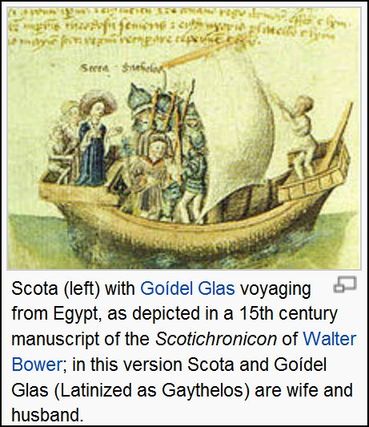
Scotland is named after Princess Scota of the aristocratic dragon lineage, who is said to have brought the sacred Stone of Destiny with her from Egypt. The Gaels are named after their common ancestor, Gael who was born in Egypt as the son of Prince Niul, who was a son of King Fenius the Antiquary of Scythia, and of Princess "Scota", a daughter of Egyptian Pharaoh "Cincris" or "Achencres". There is speculation that this "Scota" was Meritaten, the royal daughter of Akhenaten and Queen Nefertiti. She migrated after his monist religious coup failed, during a plague. She took the legendary Stone of Destiny with her.
Her name “Scota” is Scythian for “ruler of the people”. According to Nicholas de Vere, “This line descended through the Tuatha de Danaan. (the Dragon Kings of Anu), on the one hand, and the Egyptian Dragon Dynasty of Sobek on the other. The later strain included the bloodline of the Davidic House of Judah who married into the descent of the Merovingian Kings of the Franks.” Her Cult of the Dragon’s Breath (cult of the spirit of An, or Ankh) was a cult of the dead or ancestor worship.
The descendants of Gael and "Scota" fled, migrating over succeeding generations, from Egypt, first to Candia [ancient Crete], then back to their ancestral homeland of Scythia, then to the Caspian Sea for several years, then to Getulia [ancient Libya], then to Galicia [northwestern Spain], then back to Scythia, and back to Egypt again. But the Scots Gaels come directly from the second Scythian-Egyptian royal marriage. The matrilineal Dragon Queen empowered the Grail King. There is archaeological evidence of a cultural influx in the Third Millenium BC.
Another "Scota", a daughter of Pharaoh "Nectanebus", married the Gael's leader Míl [Milesius], and they sailed to the islands of Irena and Gothia, then back to Galicia, and finally on to the conquest of Ireland, the promised land of the Gaels, under the leadership of the eight sons of Míl and their mother, the second "Scota". Irish history records that Scota, the daughter of Pharaoh of Egypt arrived in the southern part of Ireland between 4,000 and 3,500 years ago. Scota is buried on the sloped mountains in view of Tralee Bay at a place called Glenscoheen (Scota's Glenn). Scota is the progenitor of Irish and Scottish kings, a royal lineage which eventually gave birth to St. Columba of Iona.
The word Iona and the Egyptian On (Heliopolis, holy place, light), are related, as is the kind of theology practiced in both places. The age-old connections between Ireland and Egypt have been guarded for millennia. On was a word used to signify the holiness of light, and was used by the Solar-Cults of Egypt and Ireland. The place-name On is probably related to the Celtic Iona, the island seat of the Druids in Scotland. When the island was a powerful Druid center it was planted with sacred groves of yew (Ioha), and the traditions of Iona involve rebirth and reincarnation.
"The Chaldeans, had the God "Iao" as the secret name of the Mystery God, that of creation. The Hebrews adopted Iao, and transformed it into YHWH, considering him/her as a national power of salvation. "Iao, Iaho, or Yaho would mean breath of life generated or springing forth between an upright male and an egg-shaped female, principles of Nature. Thus, Ye(a)va, Jehovah, Yahweh is the Hermaphrodite Supreme Divinity of the Hebrews, being Ievo-hevah, Adam-Eve, or Yod-Heva, hence, the Demiurge, preached by the alleged Moses!"
IO is the cry of the lower as OI of the higher.
In figures they are 1001; (9) in letters they are Joy. (10)
For when all is equilibrated, when all is beheld from
without all, there is joy, joy, joy that is but one
facet of a diamond, every other facet whereof is
more joyful than joy itself. --Crowley, Dragon-flies
Another name for the island is Innis nam Druineach, meaning the Island of the Cunning Workmen, or sculptors. After the arrival of St. Columba, it was also called Icolmkill, "island of Columba of the Church." Eilean Idhe means "the isle of Iona", also known as Ì nam ban bòidheach ("the isle of beautiful women"). The title of Merlin as Seer to the King is well established in Druid tradition. The Merlins preserved the Mer-Line, the umbilical to the Mother or matriarchal line (mitochondrial DNA) -- the connection to the divine feminine and the ocean of greater consciousness. Folklore says, “You walk Merlin’s line on Iona through the Mother’s landscape body to the Mother."
Columba is one of the three patron saints of Ireland. As a young royal, he was tutored by Druids. He relinquished royal claims, chose the monastic life and finally settled the dove-shaped island sanctuary of Druid overseers in 563 AD to pursue his mission. He was essentially banished from Ireland for creatively editing the scriptures. Columba could only dream about what the Archdruid Merlins knew. Both the Druids and the monks used tonsure and performed baptisms. The local Picts considered the monastery’s bronze bells very powerful shamanic medicine, instruments of art. Columba’s monastery became a glorious center of pilgrimage. The guesthouse was always occupied. At first, access was restricted to high status pilgrims, royal and ecclesiastical visitors, or those in serious trouble. Later humble pilgrims were welcomed at the Celtic Christian monastery.
Her name “Scota” is Scythian for “ruler of the people”. According to Nicholas de Vere, “This line descended through the Tuatha de Danaan. (the Dragon Kings of Anu), on the one hand, and the Egyptian Dragon Dynasty of Sobek on the other. The later strain included the bloodline of the Davidic House of Judah who married into the descent of the Merovingian Kings of the Franks.” Her Cult of the Dragon’s Breath (cult of the spirit of An, or Ankh) was a cult of the dead or ancestor worship.
The descendants of Gael and "Scota" fled, migrating over succeeding generations, from Egypt, first to Candia [ancient Crete], then back to their ancestral homeland of Scythia, then to the Caspian Sea for several years, then to Getulia [ancient Libya], then to Galicia [northwestern Spain], then back to Scythia, and back to Egypt again. But the Scots Gaels come directly from the second Scythian-Egyptian royal marriage. The matrilineal Dragon Queen empowered the Grail King. There is archaeological evidence of a cultural influx in the Third Millenium BC.
Another "Scota", a daughter of Pharaoh "Nectanebus", married the Gael's leader Míl [Milesius], and they sailed to the islands of Irena and Gothia, then back to Galicia, and finally on to the conquest of Ireland, the promised land of the Gaels, under the leadership of the eight sons of Míl and their mother, the second "Scota". Irish history records that Scota, the daughter of Pharaoh of Egypt arrived in the southern part of Ireland between 4,000 and 3,500 years ago. Scota is buried on the sloped mountains in view of Tralee Bay at a place called Glenscoheen (Scota's Glenn). Scota is the progenitor of Irish and Scottish kings, a royal lineage which eventually gave birth to St. Columba of Iona.
The word Iona and the Egyptian On (Heliopolis, holy place, light), are related, as is the kind of theology practiced in both places. The age-old connections between Ireland and Egypt have been guarded for millennia. On was a word used to signify the holiness of light, and was used by the Solar-Cults of Egypt and Ireland. The place-name On is probably related to the Celtic Iona, the island seat of the Druids in Scotland. When the island was a powerful Druid center it was planted with sacred groves of yew (Ioha), and the traditions of Iona involve rebirth and reincarnation.
"The Chaldeans, had the God "Iao" as the secret name of the Mystery God, that of creation. The Hebrews adopted Iao, and transformed it into YHWH, considering him/her as a national power of salvation. "Iao, Iaho, or Yaho would mean breath of life generated or springing forth between an upright male and an egg-shaped female, principles of Nature. Thus, Ye(a)va, Jehovah, Yahweh is the Hermaphrodite Supreme Divinity of the Hebrews, being Ievo-hevah, Adam-Eve, or Yod-Heva, hence, the Demiurge, preached by the alleged Moses!"
IO is the cry of the lower as OI of the higher.
In figures they are 1001; (9) in letters they are Joy. (10)
For when all is equilibrated, when all is beheld from
without all, there is joy, joy, joy that is but one
facet of a diamond, every other facet whereof is
more joyful than joy itself. --Crowley, Dragon-flies
Another name for the island is Innis nam Druineach, meaning the Island of the Cunning Workmen, or sculptors. After the arrival of St. Columba, it was also called Icolmkill, "island of Columba of the Church." Eilean Idhe means "the isle of Iona", also known as Ì nam ban bòidheach ("the isle of beautiful women"). The title of Merlin as Seer to the King is well established in Druid tradition. The Merlins preserved the Mer-Line, the umbilical to the Mother or matriarchal line (mitochondrial DNA) -- the connection to the divine feminine and the ocean of greater consciousness. Folklore says, “You walk Merlin’s line on Iona through the Mother’s landscape body to the Mother."
Columba is one of the three patron saints of Ireland. As a young royal, he was tutored by Druids. He relinquished royal claims, chose the monastic life and finally settled the dove-shaped island sanctuary of Druid overseers in 563 AD to pursue his mission. He was essentially banished from Ireland for creatively editing the scriptures. Columba could only dream about what the Archdruid Merlins knew. Both the Druids and the monks used tonsure and performed baptisms. The local Picts considered the monastery’s bronze bells very powerful shamanic medicine, instruments of art. Columba’s monastery became a glorious center of pilgrimage. The guesthouse was always occupied. At first, access was restricted to high status pilgrims, royal and ecclesiastical visitors, or those in serious trouble. Later humble pilgrims were welcomed at the Celtic Christian monastery.
Sacred Kindred
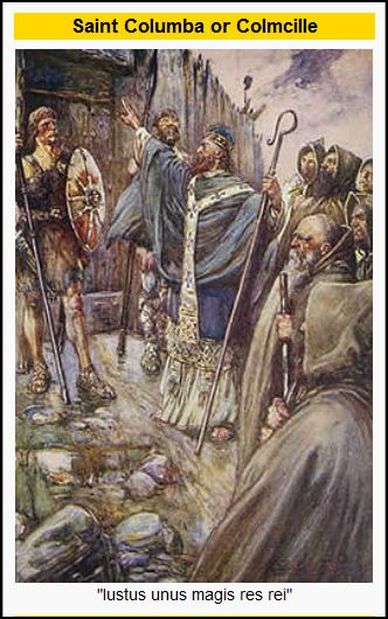
Columba took the Stone of Destiny to Iona as a portable altar. Opinions differ on whether it is related somehow to the Blarney Stone. This Lia Fal was called a “speaking stone” that named the king to be chosen. Columba used the holy stone, traditionally considered “Jacob’s pillow,” as a coronation chair for the consecration of Aedan as first King of Dal Riada, the proto-Scot Gaelic kingdom. Did he consult silently with the Stone before he did so? This singular act links Columba and Iona to the Pendragons and Grail legends. All are related by blood to the root dragon lineages of Central Asia.
King Aeden’s Merlin (Emrys) was his elder cousin. He is arguably the Merlin of Grail legends. According to Sir Laurence Gardner, the real King Arthur's father, King Aedan mac Gabran of Scots, became Pendragon by virtue of the fact that he was Prince Brychan's grandson. In this line Aedan's mother, Lleuan of Brecknock, was descended from Joseph of Arimathea who is the subject of much lore in the British Isles, including that of Glastonbury and its middle eastern "thorn tree". The name 'Uther Pendragon', meaning ‘terrible dragon’ was invented in the 12th century by the romancer Geoffrey of Monmouth (later Bishop of St. Asaph).
The true significance of King Arthur was his immediate joint descent in both the male and female lines of the Albi gens. His father was King Aedàn of Dalriada, the Pendragon of Britain in the year 559 - a descendant of the Wood Lord, Beli Mawr. His mother was Ygerna del Acqs, the daughter of Queen Viviane, whose grandson (by Ygerna’s sister, Viviane II) was the legendary Lancelot del Acqs. Ygerna (sometimes called Igraine in the Grail tradition) was the High Queen of the Celtic kingdoms and her daughter, Morgaine (by her first husband, Gwyr Llew of Carlisle), was High Priestess of the Sisters of Avallon. (Gardner)
St. Columba himself established the monarchs of Dal Riada. St. Columba correctly predicted Arthur, eldest son and natural heir to King Aeden would not live to succeed his father. In doing so, in answer to an inquiry from the Pendragon about his succession, St. Columbia’s prophecy fulfilled the ancient Druid role, essentially meaning that St. Columba was a recognized Merlin, himself. His human sacrifice of the monk Oran to fight off demons in the building of his monastery ratifies the theory. Columba took fighting demons as seriously as the Druids did.
Columba was exiled to the Scottish Isle of Iona. This island hosted a mixture of Druids, Culdean monks and priests. He built his monastery near a former Druid grove as a base for Christianizing Western Scotland. First he proved his might in battle with Druids that were aligned with Warlords. He dispelled their winds and brought light into a Magical Darkness.
Columba returned to Ireland on only one occasion, to render a verdict at Drimceatt when Aedh, the new Ard Righ, attempted to outlaw the Druid remnant or Filidh (the Druidic Poets). Columba's stature was such that his arguments for the poets saved their status and class from extinction. Columba was trained by a Druid and was not above using Druid magic to further his interests. In fact, he used them in overcoming the magicians of the Pictish king, Brude. The Celtic Christian saints engaged in many magical battles with various Magicians.
Columba began meditating on the Hill of the Angels -- Cnoc nan Aingeal. The Hill of Angels is adjacent to the Sithean, the Fairy Mound, the supernatural hotspot on Iona. These hills were the center of pagan rituals in the Bronze and Iron Ages. Columba's meditations there attracted the attention of angels passing in the distance who then came near and asked: “Who is this mortal who has turned his face away from the outer world to build a temple of God within his own body and soul?”
Legend says the angels would answer: “This is the Dove and Wolf of the church: Like the Dove, his eyes shine with infinite peace; and like the Wolf, he hungers and stalks. He wants to know more than priests are willing to teach. The church has already forgotten that the Truth is only found by listening to God speak from within the stillness of the heart. But Columba is not as these. He quests in search of God Himself.”Columba's meditation was so powerful, on those days when no angel came to visit him, Columba knew that he was needed elsewhere, and turned his attention to the outer world and to whomever came to visit the island.
King Aeden’s Merlin (Emrys) was his elder cousin. He is arguably the Merlin of Grail legends. According to Sir Laurence Gardner, the real King Arthur's father, King Aedan mac Gabran of Scots, became Pendragon by virtue of the fact that he was Prince Brychan's grandson. In this line Aedan's mother, Lleuan of Brecknock, was descended from Joseph of Arimathea who is the subject of much lore in the British Isles, including that of Glastonbury and its middle eastern "thorn tree". The name 'Uther Pendragon', meaning ‘terrible dragon’ was invented in the 12th century by the romancer Geoffrey of Monmouth (later Bishop of St. Asaph).
The true significance of King Arthur was his immediate joint descent in both the male and female lines of the Albi gens. His father was King Aedàn of Dalriada, the Pendragon of Britain in the year 559 - a descendant of the Wood Lord, Beli Mawr. His mother was Ygerna del Acqs, the daughter of Queen Viviane, whose grandson (by Ygerna’s sister, Viviane II) was the legendary Lancelot del Acqs. Ygerna (sometimes called Igraine in the Grail tradition) was the High Queen of the Celtic kingdoms and her daughter, Morgaine (by her first husband, Gwyr Llew of Carlisle), was High Priestess of the Sisters of Avallon. (Gardner)
St. Columba himself established the monarchs of Dal Riada. St. Columba correctly predicted Arthur, eldest son and natural heir to King Aeden would not live to succeed his father. In doing so, in answer to an inquiry from the Pendragon about his succession, St. Columbia’s prophecy fulfilled the ancient Druid role, essentially meaning that St. Columba was a recognized Merlin, himself. His human sacrifice of the monk Oran to fight off demons in the building of his monastery ratifies the theory. Columba took fighting demons as seriously as the Druids did.
Columba was exiled to the Scottish Isle of Iona. This island hosted a mixture of Druids, Culdean monks and priests. He built his monastery near a former Druid grove as a base for Christianizing Western Scotland. First he proved his might in battle with Druids that were aligned with Warlords. He dispelled their winds and brought light into a Magical Darkness.
Columba returned to Ireland on only one occasion, to render a verdict at Drimceatt when Aedh, the new Ard Righ, attempted to outlaw the Druid remnant or Filidh (the Druidic Poets). Columba's stature was such that his arguments for the poets saved their status and class from extinction. Columba was trained by a Druid and was not above using Druid magic to further his interests. In fact, he used them in overcoming the magicians of the Pictish king, Brude. The Celtic Christian saints engaged in many magical battles with various Magicians.
Columba began meditating on the Hill of the Angels -- Cnoc nan Aingeal. The Hill of Angels is adjacent to the Sithean, the Fairy Mound, the supernatural hotspot on Iona. These hills were the center of pagan rituals in the Bronze and Iron Ages. Columba's meditations there attracted the attention of angels passing in the distance who then came near and asked: “Who is this mortal who has turned his face away from the outer world to build a temple of God within his own body and soul?”
Legend says the angels would answer: “This is the Dove and Wolf of the church: Like the Dove, his eyes shine with infinite peace; and like the Wolf, he hungers and stalks. He wants to know more than priests are willing to teach. The church has already forgotten that the Truth is only found by listening to God speak from within the stillness of the heart. But Columba is not as these. He quests in search of God Himself.”Columba's meditation was so powerful, on those days when no angel came to visit him, Columba knew that he was needed elsewhere, and turned his attention to the outer world and to whomever came to visit the island.
Men & Magic: Columba of Iona
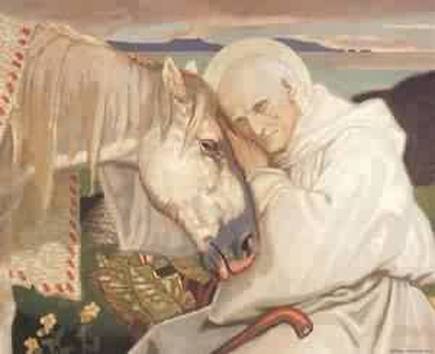
Life of St. Columba: http://www.ucc.ie/celt/online/T201040/text001.html
Reported miracles and blessings by Columba include phenomena now called 'astral travel,' remote viewing, foretelling the future, prophecy, predictions, ESP, dreams, apparitions, visions of angels and demons, visions of Divine Light, battles of supernatural wills, and out-of-body experiences. Many of them involved distance healing, secret sins, or imminent death. Did the island of Iona amplify the exile's powers?
Today, he would be called a psychic, much like the "Edgar Cayce" of his day. Many of his 'miracles' were elemental -- involving earth, air, fire or water or driving out 'demons'. Did he turn water into wine, or was the congregation hypnotically susceptible to suggestion? Ditto for turning bitter apples into sweet. Were his blessings evoking spontaneous healing or the placebo effect? Were the visions of the pious poet bard a neurological condition? He managed to amass a great deal of power with his predictions, cures, and missionary zeal.
Much has been made of Merlin’s magic but Columba’s powers in evocational magic could have made a thousand Merlins green with envy. Columba was a poet and the Druids embraced him as a bard. In the third book of St. Adamnan's Life of St. Columba, there is an episode entitled 'Of a manifestation of angels meeting the soul of one Emchath.'
Loch Ness Monster
Columba made his way beyond the ridge of Britain (Drum-Alban), the the lake of the river Nisa (Loch Ness) and was suddenly inspired by the Holy Spirit. He called to his brethren journeying with him at the time: "Let us make haste to meet the holy angels who, that they may carry away the soul of a certain man, who is keeping the moral law of nature even to extreme old age, have been sent out from the highest regions of heaven, and are waiting until we have come thither, that we may baptize him in time before he dies." Thereafter the aged saint made as much haste as he could to go in advance of his companions, until he came to the district which is named Airchartdan (Glen Urquart).' There he found 'the holy heathen man,' Emchath by name. His account of the proto-Loch Ness monster follows:
How an aquatic monster was driven off by virtue of the blessed man's prayer: when the blessed man was living for some days in the province of the Picts, he was obliged to cross the river Nesa (the Ness); and when he reached the bank of the river, he saw some of the inhabitants burying an unfortunate man, who, according to the account of those who were burying him, was a short time before seized, as he was swimming, and bitten most severely by a monster that lived in the water; his wretched body was, though too late, taken out with a hook, by those who came to his assistance in a boat. The blessed man, on hearing this, was so far from being dismayed, that he directed one of his companions to swim over and row across the coble that was moored at the farther bank. And Lugne Mocumin hearing the command of the excellent man, obeyed without the least delay, taking off all his clothes, except his tunic, and leaping into the water.
But the monster, which, so far from being satiated, was only roused for more prey, was lying at the bottom of the stream, and when it felt the water disturbed above by the man swimming, suddenly rushed out, and, giving an awful roar, darted after him, with its mouth wide open, as the man swam in the middle of the stream. Then the blessed man observing this, raised his holy hand, while all the rest, brethren as well as strangers, were stupefied with terror, and, invoking the name of God, formed the saving sign of the cross in the air, and commanded the ferocious monster, saying, ‘Thou shalt go no further, nor touch the man; go back with all speed.’ Then at the voice of the saint, the monster was terrified, and fled more quickly than if it had been pulled back with ropes, though it had just got so near to Lugne, as he swam, that there was not more than the length of a spear-staff between the man and the beast. Then the brethren seeing that the monster had gone back, and that their comrade Lugne returned to them in the boat safe and sound, were struck with admiration, and gave glory to God in the blessed man. And even the barbarous heathens, who were present, were forced by the greatness of this miracle, which they themselves had seen, to magnify the God of the Christians.
Sacred Kindred of Columba
Clearly, Columba grafted his religion on the old craft. His behavior is half-Druid magician and half Christian missionary. He tried to heal the split between the Scots and the Picts. Pict tradition was matrilinear so a system was devised for Pictish Princesses to marry Scots kings, but successors could be chosen from parallel lines of descent from sons, nephews and cousins. King Malcolm II deviated from the tradition of Druid election of successors to offer his daughter Bethoc the crown. She was married to Crinan, Irish royalty and Archpriest of the Sacred Kindred of St. Columba. The strongest hereditary claim of succession to the Scottish throne thereafter passed through Bethóc.
The only known historical candidate for the legendary Pendragon title is one Artur MacAeden, 6th century son of the Dalriadic King of Scots in Argyll, whose mother and grandmother were reputedly from British Strathclyde. This Arthur had a sister called Morgana, a nephew known as St. Kentigern, the Patron Saint of Glasgow, and some say that St. Constantine, King of Cornwall, and founder of Govan, was Arthur's uncle. We can be certain though that Arthur was distantly related to St. Columba through his father, Aeden MacGabhran, and the High Kings of Ireland. Also without doubt, is the Merlin-esque role that St. Columba played in the life of Arthur and Aeden. He chose and placed Aeden MacGabhran on the throne of Dalriada (Argyll & Ulster), and after a prophetic dream, he foretold Arthur's death.
There was only ever one Arthur born to a Pendragon - Arthur Mac Aedan of Dalriada. They "married" the land they ruled. Gardner describes how Arthur descended the Merovingian line through his mother Ygerna del Acqs. His grandmother was Viviane I, dynastic Queen of Bergundian Avallon, a Merovingian kinswoman. King Aedan was a celtic church Christian of the Sacred Kindred of St. Columba, which incorporated Druidic ritual. His sacred sister-bride in the tradition of the pharaohs, Morgaine was a Celtic Priestess, a soror mystica and holy sister of Avallon, with whom he ritually consummated the archetypal Royal Marriage, as the Egyptian royalty had done.
But alignment with the Roman church made Arthur a political and religious enemy of his own son Modred, who was Archpriest of the Sacred Kindred of Columba and an anointed Fisher King. In 608, Aedan died and was buried on Iona, similar to Arthur’s reported burial on Avalon. Is Iona the mythic Avalon? Both were entrances to the underworld. Only 6 miles of from Iona, Staffa with Fingal's Cave is the largest, most dramatic such aperture in the British Isles. The underworld of the Celts is called A-val or Avilion, the “fire of the heart.” If so, is Iona, not Glastonbury, the heart chakra of the world? Avalon was a school for Merlins, and Iona continued that tradition with a passion.
Today’s senior Stewart line claims decent from King Arthur’s father, King Aedan of Scots, on the one hand and to Prince Nascien of the Septimanian Midi on the other. The Scots descent traces further back through King Lucius of Siluria to Bran the Blessed and Joseph of Aramathea (St. James the Just), while the Midi succession stems from the Merovingians male ancestral line through the Fisher Kings to Jesus and Mary Magdalene. If the "Grail" is the sacred bloodline, it resided in Iona on multiple occasions. Its spirit never left.
The sacred Stone of Destiny remained with Iona’s monks until 843 when Viking raids caused them to move to Scone, where they used it for crowning Scottish Kings. According to an old chronicle, "no king was ever wont to reign in Scotland unless he had first, on receiving the royal name, sat upon this stone at Scone, which by the kings of old had been appointed to the capital of Alba."
In 807, the “Book of Kells” was also removed from Iona to Kells to save this luminous treasure of Celtic art from invading Vikings. Illuminated manuscripts from Iona’s scriptorium were thought to have supernatural properties. These Celtic designs were transferred to metal and stone. The Stone of Destiny was captured in 1296 by King Edward I (Long Shanks) and kept in England for 700 years. It was kept under the English throne through the coronation of Elizabeth II. It was only returned to Edinburgh in 1996 after an attempted theft.
Reported miracles and blessings by Columba include phenomena now called 'astral travel,' remote viewing, foretelling the future, prophecy, predictions, ESP, dreams, apparitions, visions of angels and demons, visions of Divine Light, battles of supernatural wills, and out-of-body experiences. Many of them involved distance healing, secret sins, or imminent death. Did the island of Iona amplify the exile's powers?
Today, he would be called a psychic, much like the "Edgar Cayce" of his day. Many of his 'miracles' were elemental -- involving earth, air, fire or water or driving out 'demons'. Did he turn water into wine, or was the congregation hypnotically susceptible to suggestion? Ditto for turning bitter apples into sweet. Were his blessings evoking spontaneous healing or the placebo effect? Were the visions of the pious poet bard a neurological condition? He managed to amass a great deal of power with his predictions, cures, and missionary zeal.
Much has been made of Merlin’s magic but Columba’s powers in evocational magic could have made a thousand Merlins green with envy. Columba was a poet and the Druids embraced him as a bard. In the third book of St. Adamnan's Life of St. Columba, there is an episode entitled 'Of a manifestation of angels meeting the soul of one Emchath.'
Loch Ness Monster
Columba made his way beyond the ridge of Britain (Drum-Alban), the the lake of the river Nisa (Loch Ness) and was suddenly inspired by the Holy Spirit. He called to his brethren journeying with him at the time: "Let us make haste to meet the holy angels who, that they may carry away the soul of a certain man, who is keeping the moral law of nature even to extreme old age, have been sent out from the highest regions of heaven, and are waiting until we have come thither, that we may baptize him in time before he dies." Thereafter the aged saint made as much haste as he could to go in advance of his companions, until he came to the district which is named Airchartdan (Glen Urquart).' There he found 'the holy heathen man,' Emchath by name. His account of the proto-Loch Ness monster follows:
How an aquatic monster was driven off by virtue of the blessed man's prayer: when the blessed man was living for some days in the province of the Picts, he was obliged to cross the river Nesa (the Ness); and when he reached the bank of the river, he saw some of the inhabitants burying an unfortunate man, who, according to the account of those who were burying him, was a short time before seized, as he was swimming, and bitten most severely by a monster that lived in the water; his wretched body was, though too late, taken out with a hook, by those who came to his assistance in a boat. The blessed man, on hearing this, was so far from being dismayed, that he directed one of his companions to swim over and row across the coble that was moored at the farther bank. And Lugne Mocumin hearing the command of the excellent man, obeyed without the least delay, taking off all his clothes, except his tunic, and leaping into the water.
But the monster, which, so far from being satiated, was only roused for more prey, was lying at the bottom of the stream, and when it felt the water disturbed above by the man swimming, suddenly rushed out, and, giving an awful roar, darted after him, with its mouth wide open, as the man swam in the middle of the stream. Then the blessed man observing this, raised his holy hand, while all the rest, brethren as well as strangers, were stupefied with terror, and, invoking the name of God, formed the saving sign of the cross in the air, and commanded the ferocious monster, saying, ‘Thou shalt go no further, nor touch the man; go back with all speed.’ Then at the voice of the saint, the monster was terrified, and fled more quickly than if it had been pulled back with ropes, though it had just got so near to Lugne, as he swam, that there was not more than the length of a spear-staff between the man and the beast. Then the brethren seeing that the monster had gone back, and that their comrade Lugne returned to them in the boat safe and sound, were struck with admiration, and gave glory to God in the blessed man. And even the barbarous heathens, who were present, were forced by the greatness of this miracle, which they themselves had seen, to magnify the God of the Christians.
Sacred Kindred of Columba
Clearly, Columba grafted his religion on the old craft. His behavior is half-Druid magician and half Christian missionary. He tried to heal the split between the Scots and the Picts. Pict tradition was matrilinear so a system was devised for Pictish Princesses to marry Scots kings, but successors could be chosen from parallel lines of descent from sons, nephews and cousins. King Malcolm II deviated from the tradition of Druid election of successors to offer his daughter Bethoc the crown. She was married to Crinan, Irish royalty and Archpriest of the Sacred Kindred of St. Columba. The strongest hereditary claim of succession to the Scottish throne thereafter passed through Bethóc.
The only known historical candidate for the legendary Pendragon title is one Artur MacAeden, 6th century son of the Dalriadic King of Scots in Argyll, whose mother and grandmother were reputedly from British Strathclyde. This Arthur had a sister called Morgana, a nephew known as St. Kentigern, the Patron Saint of Glasgow, and some say that St. Constantine, King of Cornwall, and founder of Govan, was Arthur's uncle. We can be certain though that Arthur was distantly related to St. Columba through his father, Aeden MacGabhran, and the High Kings of Ireland. Also without doubt, is the Merlin-esque role that St. Columba played in the life of Arthur and Aeden. He chose and placed Aeden MacGabhran on the throne of Dalriada (Argyll & Ulster), and after a prophetic dream, he foretold Arthur's death.
There was only ever one Arthur born to a Pendragon - Arthur Mac Aedan of Dalriada. They "married" the land they ruled. Gardner describes how Arthur descended the Merovingian line through his mother Ygerna del Acqs. His grandmother was Viviane I, dynastic Queen of Bergundian Avallon, a Merovingian kinswoman. King Aedan was a celtic church Christian of the Sacred Kindred of St. Columba, which incorporated Druidic ritual. His sacred sister-bride in the tradition of the pharaohs, Morgaine was a Celtic Priestess, a soror mystica and holy sister of Avallon, with whom he ritually consummated the archetypal Royal Marriage, as the Egyptian royalty had done.
But alignment with the Roman church made Arthur a political and religious enemy of his own son Modred, who was Archpriest of the Sacred Kindred of Columba and an anointed Fisher King. In 608, Aedan died and was buried on Iona, similar to Arthur’s reported burial on Avalon. Is Iona the mythic Avalon? Both were entrances to the underworld. Only 6 miles of from Iona, Staffa with Fingal's Cave is the largest, most dramatic such aperture in the British Isles. The underworld of the Celts is called A-val or Avilion, the “fire of the heart.” If so, is Iona, not Glastonbury, the heart chakra of the world? Avalon was a school for Merlins, and Iona continued that tradition with a passion.
Today’s senior Stewart line claims decent from King Arthur’s father, King Aedan of Scots, on the one hand and to Prince Nascien of the Septimanian Midi on the other. The Scots descent traces further back through King Lucius of Siluria to Bran the Blessed and Joseph of Aramathea (St. James the Just), while the Midi succession stems from the Merovingians male ancestral line through the Fisher Kings to Jesus and Mary Magdalene. If the "Grail" is the sacred bloodline, it resided in Iona on multiple occasions. Its spirit never left.
The sacred Stone of Destiny remained with Iona’s monks until 843 when Viking raids caused them to move to Scone, where they used it for crowning Scottish Kings. According to an old chronicle, "no king was ever wont to reign in Scotland unless he had first, on receiving the royal name, sat upon this stone at Scone, which by the kings of old had been appointed to the capital of Alba."
In 807, the “Book of Kells” was also removed from Iona to Kells to save this luminous treasure of Celtic art from invading Vikings. Illuminated manuscripts from Iona’s scriptorium were thought to have supernatural properties. These Celtic designs were transferred to metal and stone. The Stone of Destiny was captured in 1296 by King Edward I (Long Shanks) and kept in England for 700 years. It was kept under the English throne through the coronation of Elizabeth II. It was only returned to Edinburgh in 1996 after an attempted theft.
Aiden's Coronation
"How an ANGEL OF THE LORD appeared in a vision to St. Columba while he stayed in the Hinba island (Eilean-na-Naoimh), being sent to him in order that he might appoint Aidan king: ON another occasion, when this eminent man was staying in the Hinba island (Eilean-na-Naoimh), he saw, on a certain night, in a mental ecstasy, an angel sent to him from heaven, and holding in his hand a book of glass, regarding the appointment of kings. Having received the book from the hand of the angel, the venerable man, at his command, began to read it; and when he was reluctant to appoint Aidan king, as the book directed, because he had a greater affection for Iogenan his brother, the angel, suddenly stretching forth his hand, struck the saint with a scourge, the livid marks of which remained in his side all the days of his life. And he added these words: ‘Know for certain,’ said he, ‘that I am sent to thee by God with the book of glass, that in accordance with the words thou hast read therein, thou mayest inaugurate Aidan into the kingdom; but if thou refuse to obey this command, I will strike thee again.’
When therefore this angel of the Lord had appeared for three successive nights, having the same book of glass in his hand, and had repeated the same commands of the Lord regarding the appointment of the same king, the saint, in obedience to the command of the Lord, sailed across to the Iouan island (Hy, now Iona), and there ordained, as he had been commanded, Aidan to be king, who had arrived at the same time as the saint. During the words of consecration, the saint declared the future regarding the children, grandchildren and great- grandchildren of Aidan, and laying his hand upon his head, he consecrated and blessed him.
Cummene the Fair, in the book which he wrote on the virtues of St. Columba, states that St. Columba commenced his predictions regarding Aidan and his children and kingdom in the following manner: ‘Believe me, unhesitatingly, O Aidan,’ said he, ‘none of thine enemies shall be able to resist thee, unless thou first act unjustly towards me and my successors. Wherefore direct thou thy children to commend to their children, their grandchildren, and their posterity, not to let the sceptre pass out of their hands through evil counsels. For at whatever time they turn against me or my relatives who are in Hibernia, the scourge which I suffered on thy account from the angel shall bring great disgrace upon them by the hand of God, and the hearts of men shall be turned away from them, and their foes shall be greatly strengthened against them.’ Now this prophecy hath been fulfilled in our own times in the battle of Roth (Magh Rath, fought 637), in which Domnall Brecc, the grandson of Aidan, ravaged without the slightest provocation the territory of Domnall, the grandson of Ainmuire. And from that day to this they have been trodden down by strangers-a fate which pierces the heart with sighs and grief." --Life of Columba
"How an ANGEL OF THE LORD appeared in a vision to St. Columba while he stayed in the Hinba island (Eilean-na-Naoimh), being sent to him in order that he might appoint Aidan king: ON another occasion, when this eminent man was staying in the Hinba island (Eilean-na-Naoimh), he saw, on a certain night, in a mental ecstasy, an angel sent to him from heaven, and holding in his hand a book of glass, regarding the appointment of kings. Having received the book from the hand of the angel, the venerable man, at his command, began to read it; and when he was reluctant to appoint Aidan king, as the book directed, because he had a greater affection for Iogenan his brother, the angel, suddenly stretching forth his hand, struck the saint with a scourge, the livid marks of which remained in his side all the days of his life. And he added these words: ‘Know for certain,’ said he, ‘that I am sent to thee by God with the book of glass, that in accordance with the words thou hast read therein, thou mayest inaugurate Aidan into the kingdom; but if thou refuse to obey this command, I will strike thee again.’
When therefore this angel of the Lord had appeared for three successive nights, having the same book of glass in his hand, and had repeated the same commands of the Lord regarding the appointment of the same king, the saint, in obedience to the command of the Lord, sailed across to the Iouan island (Hy, now Iona), and there ordained, as he had been commanded, Aidan to be king, who had arrived at the same time as the saint. During the words of consecration, the saint declared the future regarding the children, grandchildren and great- grandchildren of Aidan, and laying his hand upon his head, he consecrated and blessed him.
Cummene the Fair, in the book which he wrote on the virtues of St. Columba, states that St. Columba commenced his predictions regarding Aidan and his children and kingdom in the following manner: ‘Believe me, unhesitatingly, O Aidan,’ said he, ‘none of thine enemies shall be able to resist thee, unless thou first act unjustly towards me and my successors. Wherefore direct thou thy children to commend to their children, their grandchildren, and their posterity, not to let the sceptre pass out of their hands through evil counsels. For at whatever time they turn against me or my relatives who are in Hibernia, the scourge which I suffered on thy account from the angel shall bring great disgrace upon them by the hand of God, and the hearts of men shall be turned away from them, and their foes shall be greatly strengthened against them.’ Now this prophecy hath been fulfilled in our own times in the battle of Roth (Magh Rath, fought 637), in which Domnall Brecc, the grandson of Aidan, ravaged without the slightest provocation the territory of Domnall, the grandson of Ainmuire. And from that day to this they have been trodden down by strangers-a fate which pierces the heart with sighs and grief." --Life of Columba
Triple Death
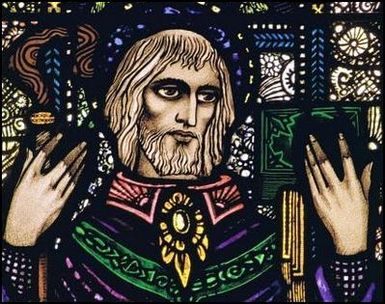
There are a number of stories in Celtic mythology that clearly are formed by the Tripartate functions of Proto-Indo-European. The theme of triple-death occurs in several places in medieval Celtic sources. The first story comes from the Life of St. Columba (Vita Columbae):
Aedh, surnamed the Black, descended of a royal family, and a Cruthinian by race. Aedh wore the clerical habit, and came with the purpose of residing with him in the monastery for some years. This Aedh the Black had been a very bloodthirsty man, and cruelly murdered many persons, amongst others Diarmuid, son of Cerbul, by divine appointment king of all. This same Aedh, then, after spending some time in his retirement, was irregularly ordained priest by a bishop invited for the purpose... The bishop, however, would not venture to lay a hand upon his head unless Findchan, who was greatly attached to Aedh, in a carnal way should first place his right hand on his head as a mark of approval. When such an ordination afterwards became known to the saint, he was deeply grieved, and in consequence forthwith pronounced this fearful sentence on the ill-fated Findchan and Aedh... And Aedh, thus irregularly ordained, shall return as a dog to his vomit, and be again a bloody murderer, until at length, pierced in the neck with a spear, he shall fall from a tree into the water and be drowned... But Aedh the Black, a priest only in name, betaking himself again to his former evil doings, and being treacherously wounded with a spear, fell from the prow of a boat into a lake and was drowned.
This story of triple-death corresponds to the elements which Evans finds in a whole host of similar stories. In all of these stories, the tripartate death is foretold. Here St. Columba foretells the triple death of Aedh. At the same time Columba's prophecy is a curse or a punishment which he dispenses to Aedh because of his sins. This leads to the next element common in many 'Triple-death' stories, the sins of the warrior. According to Dumezil, the warrior often commits a sin against each one of the functions.He is punished for each sin, with a punishment fitting for his crime. In this passage from the Life of St. Columba, three specific sins are mentioned. Aedh blasphemes by being ordained a priest outside of the Church. This is a sin against the priestly function of Indo-European society. Aedh's second sin is murder; he has killed numerous people, most notably King Diarmuid. This is a sin against the warrior function. Aedh's last sin is against the productive/fertile function in Indo-European society, he has slept with another man—an act which is by its very nature unfertile. The Tripartite death of Aedh is linked with another story of triple-death. Diarmuid, who is killed by Aedh, also dies a triple death:
When the king sent men to arrest Aedh, St. Ronan hid him and so Diarmuid had Ronan arrested and tried in his stead. He was condemned by the ecclasiastics for this act and Ronan himself uttered the famous curse, 'Desolate be Tara forever!' Soon after, Tara was abandoned, never to achieve its former splendor... [Diarmuid's wife] had an affair with Flann, so Diarmuid had Flann's fortress burnt over his head. Sorely wounded, Flann tried to escape the flames by crawling into a vat of water where he drowned... Bec Mac De [Diarmuid's druid councilor] prophesied that Diarmuid would be killed by Flann's kinsman, Aedh Dubh in the house of Banban... The manner of his death would be by slaughter, by burning, by drowning and by the ridge pole of a roof falling on his head... The Prophecy seemed so unlikely that Diarmuid scorned it, even when Banban invited him to a feast... Aedh Dubh was there and stabbed the High King with his spear. Wounded, Diarmuid fled back into the house. Aedh Dubh's men set fire to it. Seeking to escape the flame, Diarmuid scrambled into a vat of ale. A burning ridge pole fell on to his head. The prophecy was fufilled (Ellis, 84).
In this story, there is a prophecy of the threefold death before it occurs. In fact, Diarmuid's death is foretold by three different men in the original story. Diarmuid has also clearly violated two of the three functions. He sins against the sanctity of the priestly function, by trying St. Ronan. For this crime Ronan curses the throne at Tara. Diarmuid also murders Flann, a violation of the warrior function. Diarmuid is punished for his transgressions by the triple nature of his death.
Merlin
In Welsh legend, Myrddin Wylit, one of the sources for Merlin of Arthurian legend, is associated with threefold death. As a test of his skill, Merlin is asked to prophesy how a boy will die. He says the boy will fall from a rock. The same boy, with a change of clothes, is presented again, and Merlin prophesies that he will hang. Then, dressed in a girl's clothes, the boy is presented, and Merlin replies, "Woman or no, he will drown." As a young man, the victim, in a hunt, falls from a rock, is caught in a tree, and hanging head down in a lake, drowns.
Myrddin Wyllt also reportedly prophesied his own death, which would happen by falling, stabbing, and drowning. This was fulfilled when a gang of jeering shepherds drove him off a cliff, where he was impaled on a stake left by fishermen, and died with his head below water.
Arthur’s father was King Aedan of Dalriada the youngest son of King Constantine. Arthur was recognized as the King of Britain at the time his father was crowned the King of what is now Scotland. Columba ordained the two Pendragons in 575. King Constantine was the first Roman Christian monarch. Arthur was a Roman Christian as well. His mother, Igraine wanted him to make the Celtic Christian Church the Church of the Britons. Arthur’s half sister, Anna married King Loth of Lothian and had several children including Gawain and Lancelot.
Gawain, Lancelot and Arthur were all trained at a military instillation in Sweetheart which is now New Abbey across the Nith River near Dumfries. The Merlin was a mortal man as well as Arthur, Lancelot, Gawain, Constantine and King Aedan. Merlin was the title for the Seer to the King. His birth name was Emrys of Powys. He was the chief advisor for both Pendragon Kings. He was also an elder cousin of Aedan Mac Gabran. The Merlin did prophecy the future. He told King Aedan that he would be alive to see all three of his sons die in battle as the Celtic Christians fought the Roman Christians for the Head of the Island.
Arthur did have an ancestral relationship with his half-sister Morgan Le Fay that lead to the birth of a son by the name of Modred. The Celtic Church did not see this as wrong for they believe that there is a Male and a Female that makes up God. Therefore, the divine union between Morgana and Arthur was blessed. This created a whole ruler for the Celts of Britain. Morgana or Morgan Le Fey raised Modred to be the Head of the Celtic Christian Church, after Arthur proved to be a Roman Christian. Modred also had the same Roman soldier training that his father and uncles had received.
There is a misconception of Arthur being Welsh for a very good reason. During the 6th century there were two Arthurs. The one this story is based on and the second was Arthur Prince of Dyfed whom was installed by St. Dubricius in 506. This Arthur was a descendant of the Deisi leaders from Ireland that were the enemies of the Welsh. The confusion is from the Merlin connection. Merlin’s father was Aurelious of Powys. Aurelious’ wife was the sister Arthur of Dyfed. This made Merlin the nephew of Arthur of Dyfed while at the same time the cousin to Arthur Mac Gabran, the Pendragon.
The Welsh and the Scots were allies and had towns and villages of very similar names. Only with modern translations can both Arthurs be identified. King Arthur did marry Queen Gwenhwyfar of Brittany. Gwenhwyfar is know to us as Gunivere or modern translation of Jennifer. Gunivere was a Celt priestess and a Queen by her own rights. She was recorded by Columba as being a fierce fighting woman. Sir Lancelot was actually her knight before she and Arthur were married. She brought Lancelot into the Pendragon’s service. The treacherous affair between Lancelot and Gunivere was recorded by St. Columba and other scholars at the time. King Urien of Gorre made a declaration of war because he claimed Gunivere and her lands as his. King Urien actually kidnapped the Queen. Lancelot came to her rescue; that in turn led to their affair.
Aedh, surnamed the Black, descended of a royal family, and a Cruthinian by race. Aedh wore the clerical habit, and came with the purpose of residing with him in the monastery for some years. This Aedh the Black had been a very bloodthirsty man, and cruelly murdered many persons, amongst others Diarmuid, son of Cerbul, by divine appointment king of all. This same Aedh, then, after spending some time in his retirement, was irregularly ordained priest by a bishop invited for the purpose... The bishop, however, would not venture to lay a hand upon his head unless Findchan, who was greatly attached to Aedh, in a carnal way should first place his right hand on his head as a mark of approval. When such an ordination afterwards became known to the saint, he was deeply grieved, and in consequence forthwith pronounced this fearful sentence on the ill-fated Findchan and Aedh... And Aedh, thus irregularly ordained, shall return as a dog to his vomit, and be again a bloody murderer, until at length, pierced in the neck with a spear, he shall fall from a tree into the water and be drowned... But Aedh the Black, a priest only in name, betaking himself again to his former evil doings, and being treacherously wounded with a spear, fell from the prow of a boat into a lake and was drowned.
This story of triple-death corresponds to the elements which Evans finds in a whole host of similar stories. In all of these stories, the tripartate death is foretold. Here St. Columba foretells the triple death of Aedh. At the same time Columba's prophecy is a curse or a punishment which he dispenses to Aedh because of his sins. This leads to the next element common in many 'Triple-death' stories, the sins of the warrior. According to Dumezil, the warrior often commits a sin against each one of the functions.He is punished for each sin, with a punishment fitting for his crime. In this passage from the Life of St. Columba, three specific sins are mentioned. Aedh blasphemes by being ordained a priest outside of the Church. This is a sin against the priestly function of Indo-European society. Aedh's second sin is murder; he has killed numerous people, most notably King Diarmuid. This is a sin against the warrior function. Aedh's last sin is against the productive/fertile function in Indo-European society, he has slept with another man—an act which is by its very nature unfertile. The Tripartite death of Aedh is linked with another story of triple-death. Diarmuid, who is killed by Aedh, also dies a triple death:
When the king sent men to arrest Aedh, St. Ronan hid him and so Diarmuid had Ronan arrested and tried in his stead. He was condemned by the ecclasiastics for this act and Ronan himself uttered the famous curse, 'Desolate be Tara forever!' Soon after, Tara was abandoned, never to achieve its former splendor... [Diarmuid's wife] had an affair with Flann, so Diarmuid had Flann's fortress burnt over his head. Sorely wounded, Flann tried to escape the flames by crawling into a vat of water where he drowned... Bec Mac De [Diarmuid's druid councilor] prophesied that Diarmuid would be killed by Flann's kinsman, Aedh Dubh in the house of Banban... The manner of his death would be by slaughter, by burning, by drowning and by the ridge pole of a roof falling on his head... The Prophecy seemed so unlikely that Diarmuid scorned it, even when Banban invited him to a feast... Aedh Dubh was there and stabbed the High King with his spear. Wounded, Diarmuid fled back into the house. Aedh Dubh's men set fire to it. Seeking to escape the flame, Diarmuid scrambled into a vat of ale. A burning ridge pole fell on to his head. The prophecy was fufilled (Ellis, 84).
In this story, there is a prophecy of the threefold death before it occurs. In fact, Diarmuid's death is foretold by three different men in the original story. Diarmuid has also clearly violated two of the three functions. He sins against the sanctity of the priestly function, by trying St. Ronan. For this crime Ronan curses the throne at Tara. Diarmuid also murders Flann, a violation of the warrior function. Diarmuid is punished for his transgressions by the triple nature of his death.
Merlin
In Welsh legend, Myrddin Wylit, one of the sources for Merlin of Arthurian legend, is associated with threefold death. As a test of his skill, Merlin is asked to prophesy how a boy will die. He says the boy will fall from a rock. The same boy, with a change of clothes, is presented again, and Merlin prophesies that he will hang. Then, dressed in a girl's clothes, the boy is presented, and Merlin replies, "Woman or no, he will drown." As a young man, the victim, in a hunt, falls from a rock, is caught in a tree, and hanging head down in a lake, drowns.
Myrddin Wyllt also reportedly prophesied his own death, which would happen by falling, stabbing, and drowning. This was fulfilled when a gang of jeering shepherds drove him off a cliff, where he was impaled on a stake left by fishermen, and died with his head below water.
Arthur’s father was King Aedan of Dalriada the youngest son of King Constantine. Arthur was recognized as the King of Britain at the time his father was crowned the King of what is now Scotland. Columba ordained the two Pendragons in 575. King Constantine was the first Roman Christian monarch. Arthur was a Roman Christian as well. His mother, Igraine wanted him to make the Celtic Christian Church the Church of the Britons. Arthur’s half sister, Anna married King Loth of Lothian and had several children including Gawain and Lancelot.
Gawain, Lancelot and Arthur were all trained at a military instillation in Sweetheart which is now New Abbey across the Nith River near Dumfries. The Merlin was a mortal man as well as Arthur, Lancelot, Gawain, Constantine and King Aedan. Merlin was the title for the Seer to the King. His birth name was Emrys of Powys. He was the chief advisor for both Pendragon Kings. He was also an elder cousin of Aedan Mac Gabran. The Merlin did prophecy the future. He told King Aedan that he would be alive to see all three of his sons die in battle as the Celtic Christians fought the Roman Christians for the Head of the Island.
Arthur did have an ancestral relationship with his half-sister Morgan Le Fay that lead to the birth of a son by the name of Modred. The Celtic Church did not see this as wrong for they believe that there is a Male and a Female that makes up God. Therefore, the divine union between Morgana and Arthur was blessed. This created a whole ruler for the Celts of Britain. Morgana or Morgan Le Fey raised Modred to be the Head of the Celtic Christian Church, after Arthur proved to be a Roman Christian. Modred also had the same Roman soldier training that his father and uncles had received.
There is a misconception of Arthur being Welsh for a very good reason. During the 6th century there were two Arthurs. The one this story is based on and the second was Arthur Prince of Dyfed whom was installed by St. Dubricius in 506. This Arthur was a descendant of the Deisi leaders from Ireland that were the enemies of the Welsh. The confusion is from the Merlin connection. Merlin’s father was Aurelious of Powys. Aurelious’ wife was the sister Arthur of Dyfed. This made Merlin the nephew of Arthur of Dyfed while at the same time the cousin to Arthur Mac Gabran, the Pendragon.
The Welsh and the Scots were allies and had towns and villages of very similar names. Only with modern translations can both Arthurs be identified. King Arthur did marry Queen Gwenhwyfar of Brittany. Gwenhwyfar is know to us as Gunivere or modern translation of Jennifer. Gunivere was a Celt priestess and a Queen by her own rights. She was recorded by Columba as being a fierce fighting woman. Sir Lancelot was actually her knight before she and Arthur were married. She brought Lancelot into the Pendragon’s service. The treacherous affair between Lancelot and Gunivere was recorded by St. Columba and other scholars at the time. King Urien of Gorre made a declaration of war because he claimed Gunivere and her lands as his. King Urien actually kidnapped the Queen. Lancelot came to her rescue; that in turn led to their affair.
Land of Legends
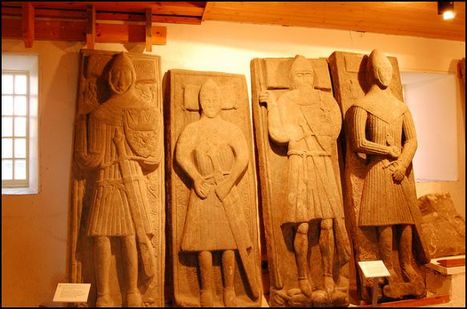
Iona, the primordial Dreamland is a magical burial place of over 60 Kings, including the Scots Macbeth and his victim Duncan. Known graves include 48 Scottish, 8 Norwegian, 1 French and 4 Irish kings plus numerous clan chiefs. Templar knight gravestones reveal their presence on the island. Megalithic remains suggest it was a prehistoric burial site, too. Iona is a borderland between life and death. Those buried there often arrived while still alive to prepare for their final journey. The monks essentially died while living a very solitary life. A beehive cell or single hermitage was called a ‘disert.’
An island legend tells of a lonely monk who fell in love with a mermaid. When she was banished, she shed tears that can be found today as small green tear-shaped crystals along Iona’s beaches. There are also legends about magical “green eggs,” called Druid’s Eggs or Serpent’s Eggs. Iona’s other tales include Blood Eagle tortures of monks by Vikings, Fairy Ointment, Place of the Great Crosses, human sacrifice, Earthworks, “House of the Fairies,” Culdees, and Moneymusk Reliquary -- even Atlantean priestesses. Staffa the nearest uninhabited island facing Iona displays the gaping maw of the astonishing Fingal’s Cave, the Scottish end of the Giant’s Causeway, noted for its massive basalt columns. The giant's cave was a Druid initiation chamber. Looking out from inside this extraordinary cave, Iona is framed in the entrance. Both islands form an initiatory circuit. Caves are portals to the underworld, the world of the dead.
Columba, the Celtic Saint was a wanderer. He realized he had no abiding home on earth. Many early monks left their homes as a sign of the spiritual quest - the white martyrdom. One of these monks was Saint Columba - a nobleman of one of the leading families in Ireland. With some other companions, including his cousin Beathain (Bean), he settled in the isle of I - Iona. While there he sailed up Loch Ness to negotiate with the Pictish king, Brude at Inverness. On the way he is recorded to have encountered (and tamed) the "water horse" which dwelt in Loch Ness. He baptized natives along the banks of the Ness, and eventually left his cousin in Cannich, where he is traditionally held to have founded the cell known as Kil Beathain - now Clachan Comar. Above Clachan Comar is the spring still known as St. Bean’s spring.
Other ancient stories tell of Joseph of Arimathea visiting the island to trade in tin; some include his young nephew Jesus accompanying him. Another legend says Mary Magdalene was buried in a cave on Iona and in the future a Divine Woman from the fair isle will redeem the world. Though less is known of its pagan past, much more has been written on the Christian history of Iona after Columba drove out a rival monastic order, not the indigenous Druids, as is frequently but wrongly reported. But even Iona’s Celtic Christianity must be seen in a pagan light. This was not the Roman church.
The monastics of Iona lived simple, often solitary lives. The “Black Nuns” on Iona followed the teaching of St. Augustine of Hippo, in Egypt. They wore black habits, and their church was locally called an eaglais dhubh (‘the black church’). They pursued a contemplative and cloistered life. Their first prioress was Bethoc. Gravestones demonstrate the nunnery was favored for retirement and burial for ladies of noble birth from across the western seaboard. The ninth Abbot of Iona, who wrote the hagiography of St. Columba, demonstrates the hereditary succession: Adomnán was a descendant of Colman mac Setna, a cousin of St. Columba and the ancestor, through his son Ainmire, of the kings of Cenel Conaill. He was the son of Ronan mac Tinne by Ronat, a woman from the (northern Ui Neill lineage known as the Cenél nÉnda.
An island legend tells of a lonely monk who fell in love with a mermaid. When she was banished, she shed tears that can be found today as small green tear-shaped crystals along Iona’s beaches. There are also legends about magical “green eggs,” called Druid’s Eggs or Serpent’s Eggs. Iona’s other tales include Blood Eagle tortures of monks by Vikings, Fairy Ointment, Place of the Great Crosses, human sacrifice, Earthworks, “House of the Fairies,” Culdees, and Moneymusk Reliquary -- even Atlantean priestesses. Staffa the nearest uninhabited island facing Iona displays the gaping maw of the astonishing Fingal’s Cave, the Scottish end of the Giant’s Causeway, noted for its massive basalt columns. The giant's cave was a Druid initiation chamber. Looking out from inside this extraordinary cave, Iona is framed in the entrance. Both islands form an initiatory circuit. Caves are portals to the underworld, the world of the dead.
Columba, the Celtic Saint was a wanderer. He realized he had no abiding home on earth. Many early monks left their homes as a sign of the spiritual quest - the white martyrdom. One of these monks was Saint Columba - a nobleman of one of the leading families in Ireland. With some other companions, including his cousin Beathain (Bean), he settled in the isle of I - Iona. While there he sailed up Loch Ness to negotiate with the Pictish king, Brude at Inverness. On the way he is recorded to have encountered (and tamed) the "water horse" which dwelt in Loch Ness. He baptized natives along the banks of the Ness, and eventually left his cousin in Cannich, where he is traditionally held to have founded the cell known as Kil Beathain - now Clachan Comar. Above Clachan Comar is the spring still known as St. Bean’s spring.
Other ancient stories tell of Joseph of Arimathea visiting the island to trade in tin; some include his young nephew Jesus accompanying him. Another legend says Mary Magdalene was buried in a cave on Iona and in the future a Divine Woman from the fair isle will redeem the world. Though less is known of its pagan past, much more has been written on the Christian history of Iona after Columba drove out a rival monastic order, not the indigenous Druids, as is frequently but wrongly reported. But even Iona’s Celtic Christianity must be seen in a pagan light. This was not the Roman church.
The monastics of Iona lived simple, often solitary lives. The “Black Nuns” on Iona followed the teaching of St. Augustine of Hippo, in Egypt. They wore black habits, and their church was locally called an eaglais dhubh (‘the black church’). They pursued a contemplative and cloistered life. Their first prioress was Bethoc. Gravestones demonstrate the nunnery was favored for retirement and burial for ladies of noble birth from across the western seaboard. The ninth Abbot of Iona, who wrote the hagiography of St. Columba, demonstrates the hereditary succession: Adomnán was a descendant of Colman mac Setna, a cousin of St. Columba and the ancestor, through his son Ainmire, of the kings of Cenel Conaill. He was the son of Ronan mac Tinne by Ronat, a woman from the (northern Ui Neill lineage known as the Cenél nÉnda.
Prehistoric Spirituality
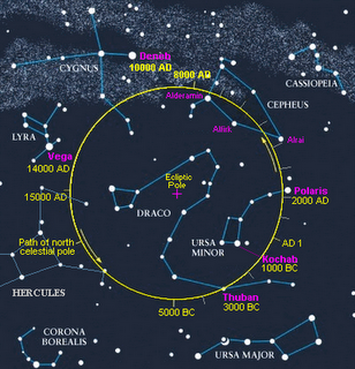
Prehistoric Deluge: Meltwater Pulse 1A
Narratives are frames best read in the context of their own cultural, mythological and philosophical origins. Perspective defines how wide or narrow that view is – broad or fine strokes. The story of Iona begins in Atlantis, both a literal story of radical changes in coastal geomorphology from cyclical natural catastrophe as well as a metaphor of ancient wisdom sinking into the subconscious.
We don't have to give such a place or time a name, but simply say, "Before a near-extinction." The best known meltwater pulses is referred to as Meltwater Pulse 1A (mwp-1A), which started at around 14,200 years ago and lasted for close to 500 years. Over this short period, sea level rose approximately 20 m – or around 40 mm/y – almost 7 times the average rate.
The late Ice Age comet impact on the Laurentian Ice Sheet, melted enough ice to create the evidence of super flooding seen in the St. Lawrence, Mississippi water ways and the fresh water spike seen in the sediments on the floor of the gulf of México. This large impact event plausibly created a "Nuclear Winter". As the super flood of water entered the oceans, the sea level began to raise.
The rise in sea level, though small, was enough to lift the edges of the grounded Continental Ice Sheets which were in a precarious balance with the warming of the climate and frequent surges into the sea. It tipped the balance and caused a massive entry of glacial ice from the Laurentian Ice Sheet into the Atlantic ocean and created the 1A event of scatted stones found throughout the North Atlantic floor sediments. Stones dropped from the ice as it melted in the ocean as the huge surge of glacial ice drifted far and wide.
This wholesale entry of Glacial ice into the world oceans in the massive 1A event, raised sea level world wide in a matter of days by quite a number of feet. This sudden huge rise in sea level could have destabilized the other Ice Sheets and Glaciers which existed in Ice Age, and could have resulted in a domino chain reaction as one glacier after another slid into the sea, with each one raising the sea level higher and causing more glaciers to surge into the sea in a run away chain reaction.
In the Ice Ages, Britain was a peninsula of Europe. Doggerland was the heart of mesolithic culture. It began sinking Doggerland, the landbridge linking the British Isles with Europe, changing migratory patterns and creating pockets of isolation. Sea level began to rise before 15,000 BC as soon as the ice sheets began to recede. The most rapid phases were between 8000 BC and 5000 BC, and the general increase was effectively over by 2000 BC when it may have been one or 2 m higher than today.Mega-fauna became extinct. Freshwater disruption of the thermohaline oceanic pump led to the Younger Dryas glacial period, which subsided 6,500 years ago. A Holocene submarine landslide off Norway created a huge tsunami that finished off Doggerland, making it part of the North Sea.
Others would have witnessed the sea racing inland at the breaching of a shingle ridge or dune. Still others such as the inhabitants of what would one day become the town of Inverness in eastern Scotland faced catastrophe. Archaeologists have recovered almost 5,000 flint artifacts, bone fragments and a fireplace so far. On some day close to 7,000BC a small group of Mesolithic hunters were in a natural hollow in the dune. A few hours earlier, the massive sub-marine Storegga landslide occurred 1,000km to the north within the Arctic Ocean between Norway and Iceland.
Profiles across the scarp show the great change in the seismic character of the disturbed sediments. They become jumbled, massive and form an irregular sea-bed, and produce strongly hyperbolic immediately below the scarp. Seismic reflection profile from the Storegga Slide.
It created a huge tsunami that probably hit their beach with a height of 8m. More than 17,000 cubic kilometers of white, stony sand buried everything as far as could be seen to the north and south. The impact of this tsunami across the low-lying coast of Doggerland must have been devastating. Many km of coastline are likely to have been destroyed
within a few hours, perhaps minutes and many lives were lost.
Another catastrophe happened on the other side of Europe 3,500km away. The victims lived on the shore of the freshwater lake that would become the Black Sea. The lowlands around the lake provided flat fertile soil covered with oak woodlands in which people hunted and gathered for thousands of years. By the date of the event, however, a new people had arrived: Neolithic farmers. They had come from Turkey and settled on the rich alluvial soil; felling trees to make way for fields of wheat and barley and to provide wood for their houses, fences, and pens for cattle and goats. The Black Sea had become a lake during the Ice Age.
The settlement of Britain by early modern humans commenced before the last glacial maximum (LGM, 19–23 000 BP; Mix et al. 2001), but the ice advance during it led to the British Isles being abandoned by temperate species, including humans (Barton et al. 2003). Although a variety of scenarios have been proposed based on archaeological and genetic data, there is still debate over the nature and timing of the reoccupation of the British Isles by humans after the LGM (Oppenheimer 2006; Conneller 2007; Jacobi & Higham 2009). Likewise, linked in with these scenarios, there is much discussion on the regional impact (both biologically and culturally) of subsequent human migrations into the British Isles.
In terms of current regional distributions in the British Isles, the long-standing human occupants of the western and northern periphery are distinct culturally and genetically from those in central and eastern Britain (Davies 1999; Forster et al. 2004; Oppenheimer 2006). The cultural distinctiveness is most evident at present through the separation of the peripheral people and areas into the nations of Scotland, Ireland (Northern Ireland and the Republic of Ireland) and Wales, the dependency of the Isle of Man and the most westerly English county of Cornwall. The central and eastern areas and the people within them constitute England. The traditional languages in the peripheral areas (Scottish Gaelic, Irish Gaelic, Welsh, Manx and Cornish) are closely related to each other linguistically (Forster & Toth 2003) and distinctive from English. Genetically, there are differences between people in the peripheral areas and those in England; for example, in peripheral areas there are high frequencies of individuals with the mtDNA marker J/16192 and belonging to the Y-chromosomal gene cluster R1b-14, while J/16231 and I1a occur at high frequencies in England (Forster et al. 2004; Oppenheimer 2006).
While the pattern is clear, the processes that led to that pattern remain contentious. The vernacular name for the peripheral regions and people within them is the Celtic fringe, which also includes Brittany in north-western France. This reflects a traditional scenario that Celts spread into and occupied the whole of the British Isles by 2600 BP, replacing earlier inhabitants. It is generally assumed that the Celts remained numerically dominant and geographically widespread until they were themselves partially replaced by Anglo-Saxons at approximately 1600–1200 BP, resulting in the Anglo-Saxon territory of ‘England’ and a peripheral fringe of Celtic people, which has persisted to the present day (Davies 1999). However, this scenario is controversial among historians and human geneticists and, while supported by some, alternative scenarios involve, for example, greater persistence of pre-Celtic people, and cultural spread rather than population replacement by the Anglo-Saxons (Davies 1999; Burmeister 2000; Weale et al. 2002; Capelli et al. 2003; Oppenheimer 2006). Therefore, interpretation of the human pattern may need to take into account the aspects of human migration leading all the way back to the recolonization of the British Isles after the LGM.
The Human Effects
With the fall of "Atlantis", the collective psyche of humankind began to degenerate. The esoteric map of Atlantis is a map of transformation. Deep within there is an Atlantis of the soul, from which we yearn to recover what we sense has been lost – our potential for transcendence. But it is ‘transparency’ that makes us seers by allowing us to see through the veil of history and legend. Rather than answers, we might only find better questions. Very little informs us of who lived in Scotland from 10,000 B.C. until the Megalithic Age, roughly 3500 B.C. to 1500 B.C. Perhaps some of the earliest ancestors were refugees from the Atlantean Deluge.
The primordial solar church existed in proto-Ireland before the historically known "Druids." The Megalithic Irish (or Arish) were known as the Hyperboreans, which implied not only that they inhabited Northern climes but that they were the descendants of the pre-diluvian inhabitants of Atlantis, before the cataclysms that devastated the lands of the North-West.
During the so-called "Age of Catastrophe," titanic cataclysms (following on from those that destroyed Atlantis) displaced the original inhabitants of Britain, who were forced to flee to the Continent across land-bridges now lost beneath the waves and known as Doggerland. The lost ground is a vast plain that joined Britain to Europe for nearly 12,000 years, until sea levels began rising dramatically after the last Ice Age. Taking its name from a prominent shipping hazard—Dogger Bank—this immense land bridge vanished beneath the North Sea around 6,000 B.C.
Evidence suggests early migrations from the West to the East, preceding a return of the Scythian Druid kings. The Black Sea princes settled in Ireland about 800 BC. Arguably, it was the former who transmitted the elements of civilization to the world at large, before the return waves of Celtic-Scythian "Druids". Anciently, they were one. But the Royal Scyths were masters of transcendent consciousness, called Sidhe (pronounced “Shee”), which colloquially means fairy or elf, but translates as ‘powers’. Many religious symbols were first employed by the Druid elders of the West, from the "Land of the Pure or Noble Ones." The high priests of Ireland were commonly known as Druids.
The ancient priests were hereditary serpent kings who founded mystery schools. The Druids held the symbols of the serpent and the dragon in the highest esteem and considered them insignias of royalty. They referred to themselves as Naddreds, meaning "Wise Serpents” -- those initiated into the highest mysteries, that possessed healing abilities and great knowledge of architecture, astronomy and astrology. The Druid's pre-diluvian theology was based on the observance and veneration of the stars, of the sun, the moon, and the zodiac. From its inception, Druidry was a stellar religion. It is linked to the words for 'door' or portal and 'bringer of truth.’
West to East Celtic expansion - http://www.enter.net/~torve/trogholm/wonder/indoeuropean/indoeuropean3.html
Below: Fountain of Youth on Dun-I peak
Narratives are frames best read in the context of their own cultural, mythological and philosophical origins. Perspective defines how wide or narrow that view is – broad or fine strokes. The story of Iona begins in Atlantis, both a literal story of radical changes in coastal geomorphology from cyclical natural catastrophe as well as a metaphor of ancient wisdom sinking into the subconscious.
We don't have to give such a place or time a name, but simply say, "Before a near-extinction." The best known meltwater pulses is referred to as Meltwater Pulse 1A (mwp-1A), which started at around 14,200 years ago and lasted for close to 500 years. Over this short period, sea level rose approximately 20 m – or around 40 mm/y – almost 7 times the average rate.
The late Ice Age comet impact on the Laurentian Ice Sheet, melted enough ice to create the evidence of super flooding seen in the St. Lawrence, Mississippi water ways and the fresh water spike seen in the sediments on the floor of the gulf of México. This large impact event plausibly created a "Nuclear Winter". As the super flood of water entered the oceans, the sea level began to raise.
The rise in sea level, though small, was enough to lift the edges of the grounded Continental Ice Sheets which were in a precarious balance with the warming of the climate and frequent surges into the sea. It tipped the balance and caused a massive entry of glacial ice from the Laurentian Ice Sheet into the Atlantic ocean and created the 1A event of scatted stones found throughout the North Atlantic floor sediments. Stones dropped from the ice as it melted in the ocean as the huge surge of glacial ice drifted far and wide.
This wholesale entry of Glacial ice into the world oceans in the massive 1A event, raised sea level world wide in a matter of days by quite a number of feet. This sudden huge rise in sea level could have destabilized the other Ice Sheets and Glaciers which existed in Ice Age, and could have resulted in a domino chain reaction as one glacier after another slid into the sea, with each one raising the sea level higher and causing more glaciers to surge into the sea in a run away chain reaction.
In the Ice Ages, Britain was a peninsula of Europe. Doggerland was the heart of mesolithic culture. It began sinking Doggerland, the landbridge linking the British Isles with Europe, changing migratory patterns and creating pockets of isolation. Sea level began to rise before 15,000 BC as soon as the ice sheets began to recede. The most rapid phases were between 8000 BC and 5000 BC, and the general increase was effectively over by 2000 BC when it may have been one or 2 m higher than today.Mega-fauna became extinct. Freshwater disruption of the thermohaline oceanic pump led to the Younger Dryas glacial period, which subsided 6,500 years ago. A Holocene submarine landslide off Norway created a huge tsunami that finished off Doggerland, making it part of the North Sea.
Others would have witnessed the sea racing inland at the breaching of a shingle ridge or dune. Still others such as the inhabitants of what would one day become the town of Inverness in eastern Scotland faced catastrophe. Archaeologists have recovered almost 5,000 flint artifacts, bone fragments and a fireplace so far. On some day close to 7,000BC a small group of Mesolithic hunters were in a natural hollow in the dune. A few hours earlier, the massive sub-marine Storegga landslide occurred 1,000km to the north within the Arctic Ocean between Norway and Iceland.
Profiles across the scarp show the great change in the seismic character of the disturbed sediments. They become jumbled, massive and form an irregular sea-bed, and produce strongly hyperbolic immediately below the scarp. Seismic reflection profile from the Storegga Slide.
It created a huge tsunami that probably hit their beach with a height of 8m. More than 17,000 cubic kilometers of white, stony sand buried everything as far as could be seen to the north and south. The impact of this tsunami across the low-lying coast of Doggerland must have been devastating. Many km of coastline are likely to have been destroyed
within a few hours, perhaps minutes and many lives were lost.
Another catastrophe happened on the other side of Europe 3,500km away. The victims lived on the shore of the freshwater lake that would become the Black Sea. The lowlands around the lake provided flat fertile soil covered with oak woodlands in which people hunted and gathered for thousands of years. By the date of the event, however, a new people had arrived: Neolithic farmers. They had come from Turkey and settled on the rich alluvial soil; felling trees to make way for fields of wheat and barley and to provide wood for their houses, fences, and pens for cattle and goats. The Black Sea had become a lake during the Ice Age.
The settlement of Britain by early modern humans commenced before the last glacial maximum (LGM, 19–23 000 BP; Mix et al. 2001), but the ice advance during it led to the British Isles being abandoned by temperate species, including humans (Barton et al. 2003). Although a variety of scenarios have been proposed based on archaeological and genetic data, there is still debate over the nature and timing of the reoccupation of the British Isles by humans after the LGM (Oppenheimer 2006; Conneller 2007; Jacobi & Higham 2009). Likewise, linked in with these scenarios, there is much discussion on the regional impact (both biologically and culturally) of subsequent human migrations into the British Isles.
In terms of current regional distributions in the British Isles, the long-standing human occupants of the western and northern periphery are distinct culturally and genetically from those in central and eastern Britain (Davies 1999; Forster et al. 2004; Oppenheimer 2006). The cultural distinctiveness is most evident at present through the separation of the peripheral people and areas into the nations of Scotland, Ireland (Northern Ireland and the Republic of Ireland) and Wales, the dependency of the Isle of Man and the most westerly English county of Cornwall. The central and eastern areas and the people within them constitute England. The traditional languages in the peripheral areas (Scottish Gaelic, Irish Gaelic, Welsh, Manx and Cornish) are closely related to each other linguistically (Forster & Toth 2003) and distinctive from English. Genetically, there are differences between people in the peripheral areas and those in England; for example, in peripheral areas there are high frequencies of individuals with the mtDNA marker J/16192 and belonging to the Y-chromosomal gene cluster R1b-14, while J/16231 and I1a occur at high frequencies in England (Forster et al. 2004; Oppenheimer 2006).
While the pattern is clear, the processes that led to that pattern remain contentious. The vernacular name for the peripheral regions and people within them is the Celtic fringe, which also includes Brittany in north-western France. This reflects a traditional scenario that Celts spread into and occupied the whole of the British Isles by 2600 BP, replacing earlier inhabitants. It is generally assumed that the Celts remained numerically dominant and geographically widespread until they were themselves partially replaced by Anglo-Saxons at approximately 1600–1200 BP, resulting in the Anglo-Saxon territory of ‘England’ and a peripheral fringe of Celtic people, which has persisted to the present day (Davies 1999). However, this scenario is controversial among historians and human geneticists and, while supported by some, alternative scenarios involve, for example, greater persistence of pre-Celtic people, and cultural spread rather than population replacement by the Anglo-Saxons (Davies 1999; Burmeister 2000; Weale et al. 2002; Capelli et al. 2003; Oppenheimer 2006). Therefore, interpretation of the human pattern may need to take into account the aspects of human migration leading all the way back to the recolonization of the British Isles after the LGM.
The Human Effects
With the fall of "Atlantis", the collective psyche of humankind began to degenerate. The esoteric map of Atlantis is a map of transformation. Deep within there is an Atlantis of the soul, from which we yearn to recover what we sense has been lost – our potential for transcendence. But it is ‘transparency’ that makes us seers by allowing us to see through the veil of history and legend. Rather than answers, we might only find better questions. Very little informs us of who lived in Scotland from 10,000 B.C. until the Megalithic Age, roughly 3500 B.C. to 1500 B.C. Perhaps some of the earliest ancestors were refugees from the Atlantean Deluge.
The primordial solar church existed in proto-Ireland before the historically known "Druids." The Megalithic Irish (or Arish) were known as the Hyperboreans, which implied not only that they inhabited Northern climes but that they were the descendants of the pre-diluvian inhabitants of Atlantis, before the cataclysms that devastated the lands of the North-West.
During the so-called "Age of Catastrophe," titanic cataclysms (following on from those that destroyed Atlantis) displaced the original inhabitants of Britain, who were forced to flee to the Continent across land-bridges now lost beneath the waves and known as Doggerland. The lost ground is a vast plain that joined Britain to Europe for nearly 12,000 years, until sea levels began rising dramatically after the last Ice Age. Taking its name from a prominent shipping hazard—Dogger Bank—this immense land bridge vanished beneath the North Sea around 6,000 B.C.
Evidence suggests early migrations from the West to the East, preceding a return of the Scythian Druid kings. The Black Sea princes settled in Ireland about 800 BC. Arguably, it was the former who transmitted the elements of civilization to the world at large, before the return waves of Celtic-Scythian "Druids". Anciently, they were one. But the Royal Scyths were masters of transcendent consciousness, called Sidhe (pronounced “Shee”), which colloquially means fairy or elf, but translates as ‘powers’. Many religious symbols were first employed by the Druid elders of the West, from the "Land of the Pure or Noble Ones." The high priests of Ireland were commonly known as Druids.
The ancient priests were hereditary serpent kings who founded mystery schools. The Druids held the symbols of the serpent and the dragon in the highest esteem and considered them insignias of royalty. They referred to themselves as Naddreds, meaning "Wise Serpents” -- those initiated into the highest mysteries, that possessed healing abilities and great knowledge of architecture, astronomy and astrology. The Druid's pre-diluvian theology was based on the observance and veneration of the stars, of the sun, the moon, and the zodiac. From its inception, Druidry was a stellar religion. It is linked to the words for 'door' or portal and 'bringer of truth.’
West to East Celtic expansion - http://www.enter.net/~torve/trogholm/wonder/indoeuropean/indoeuropean3.html
Below: Fountain of Youth on Dun-I peak
Dragon Age
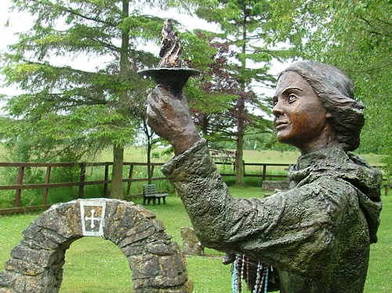
These "enlighteners" were fully aware of the 26,000-year cycle of Precession of the Equinoxes. When their line arose, the star Thuban in the constellation Draco was the pole star. They were a hereditary caste of seers, philosophers, political advisors, priests, natural scientists, historians, doctors of medicine, judges, poets, royal advisors, musicians, geometers, orators, navigators, and magicians. The Bards sang oracular songs. They preserved 'knowledge' or gnosis. The solar deity of Beltane was known as Bel, Beli, Belanus, celebrated with vast bonfires. Iona still echoes symbols of the ancient solar cult on Easter, displaying an altar cloth showing the reborn rising sun.
Druidry recognizes eight markers in the shamanic Solar cycle. Winter Solstice, called Alban Arthan [the Light of Arthur] is the time of death and rebirth. The sun appears to be abandoning us completely as the longest night arrives; it stops in its tracks. Our own inner journey is linked to the yearly cycle, in which whatever impedes the appearance of light or holds us back must be cast away. As one lamp is lit from a flint and raised up on the Druid's crook in the East, the year is reborn and a new cycle begins.
The dynamic between body and soul is revealed in the Druid natural philosophy of reincarnation, not in immediate rebirth but in reincorporation of the spirit into a new body after a length of time. Transmigration is symbolized by the serpent that sheds its skin. Funeral pyres were considered portals through which one could send “letters” to the dead. Memories arise with no known reality. Old patterns die so that new psychic patterns are born through the void’s grace. Iona gives us the grace to breathe that void. Empty space is Iona’s central metaphor, informing the vacuum. We become containers for the ceaseless flow of images. Second sight means to “know again.” We re-cognize our own images. We embody the idea of ancient hidden knowledge being carried through to our own time.
From the light of Albion, the light of consciousness radiates out to the world. Some legends mirror the solar cycle, claiming Jesus and Mary Magdalene were on Iona, where she gave birth to His son, John Martinus. We can assume a spiritual significance for the association that implies a family lineage, a holy bloodline older than Jesus. Does Mary Magdalene lie buried in a hidden cave on Iona? She was worshipped there as the Holy (Saint) Bride, “Mary of the Gael.” The children and descendants of early Celtic saints, both male and female, belonged to the old British royal lineages. Does the Martin’s Cross on Iona, with its solar circle, encode such memories for those who can read them?
The Winter Solstice, Alban Arthan, represents a time to open to inspiration and conception. All about us is darkness. Our only guide is Arthur, the Great Bear, the Pole Star (or the Southern Cross in the Southern hemisphere). Intuition is born in the stillness of night. This is the mystery of the rebirth of the inner light within us. The Winter Solstice is the time when the seed of Light, represented both by the one light raised on high and by the white mistletoe berries, comes down from the inspired realms and incarnates in the womb of the night and of the Earth Mother.
This is a potent time to open ourselves to the fertilizing power of the divine, which gives birth to our creativity. The Druid’s yew tree, Ioha, is a symbol of immortality. Great yew trees can be 2-4,000 years old whereas Iona’s churches are far newer. The yews came first, planted on sacred sites of the Druids. Regardless of their symbolic names, the elements of light, consciousness and rebirth are woven and rewoven.
Druidry recognizes eight markers in the shamanic Solar cycle. Winter Solstice, called Alban Arthan [the Light of Arthur] is the time of death and rebirth. The sun appears to be abandoning us completely as the longest night arrives; it stops in its tracks. Our own inner journey is linked to the yearly cycle, in which whatever impedes the appearance of light or holds us back must be cast away. As one lamp is lit from a flint and raised up on the Druid's crook in the East, the year is reborn and a new cycle begins.
The dynamic between body and soul is revealed in the Druid natural philosophy of reincarnation, not in immediate rebirth but in reincorporation of the spirit into a new body after a length of time. Transmigration is symbolized by the serpent that sheds its skin. Funeral pyres were considered portals through which one could send “letters” to the dead. Memories arise with no known reality. Old patterns die so that new psychic patterns are born through the void’s grace. Iona gives us the grace to breathe that void. Empty space is Iona’s central metaphor, informing the vacuum. We become containers for the ceaseless flow of images. Second sight means to “know again.” We re-cognize our own images. We embody the idea of ancient hidden knowledge being carried through to our own time.
From the light of Albion, the light of consciousness radiates out to the world. Some legends mirror the solar cycle, claiming Jesus and Mary Magdalene were on Iona, where she gave birth to His son, John Martinus. We can assume a spiritual significance for the association that implies a family lineage, a holy bloodline older than Jesus. Does Mary Magdalene lie buried in a hidden cave on Iona? She was worshipped there as the Holy (Saint) Bride, “Mary of the Gael.” The children and descendants of early Celtic saints, both male and female, belonged to the old British royal lineages. Does the Martin’s Cross on Iona, with its solar circle, encode such memories for those who can read them?
The Winter Solstice, Alban Arthan, represents a time to open to inspiration and conception. All about us is darkness. Our only guide is Arthur, the Great Bear, the Pole Star (or the Southern Cross in the Southern hemisphere). Intuition is born in the stillness of night. This is the mystery of the rebirth of the inner light within us. The Winter Solstice is the time when the seed of Light, represented both by the one light raised on high and by the white mistletoe berries, comes down from the inspired realms and incarnates in the womb of the night and of the Earth Mother.
This is a potent time to open ourselves to the fertilizing power of the divine, which gives birth to our creativity. The Druid’s yew tree, Ioha, is a symbol of immortality. Great yew trees can be 2-4,000 years old whereas Iona’s churches are far newer. The yews came first, planted on sacred sites of the Druids. Regardless of their symbolic names, the elements of light, consciousness and rebirth are woven and rewoven.
Druid Isle
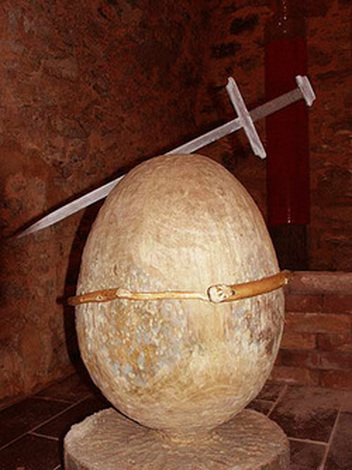
An influx of proto-Celtic, Bell Beaker people into Britain is now dated from 2900 - 1800/1700 BC. They brought beer, new beliefs about life and death, divination, farming techniques, and mortuary practices along with the art of metallurgy to the Neolithic culture. Groups assimilated in complicated patterns of movement that involved explorations, contact, settlement, diffusion and acculturation. This culture spread from Ireland to the Carpathian Basin and south along the Atlantic coast to Portugal, Spain, France, North Africa, Sicily, Italy, the Balkans, and Germany. These trade routes remained open. Their shamans were Druids, whose power came from contact with the spirit world.
Megalithic Druids preceded the later Celtic influx. Some suggest early migrations from the late ice ages to Scythia and back make the megalithic Druid lines “cousins” to their Indo-European invaders. Pre-Celts and proto-Celts are linked by the royal Dragon and Pendragon bloodlines. We can trace the dragon lineage, not only to a clan totem, but to the astronomical fact that from roughly 4,000-1,000 BC Thuban in the constellation Draco was the pole star, around which the heavens revolved. The Druid's pre-diluvian theology was based on the observance and veneration of the stars, of the sun, the moon, and the zodiac. From its inception it was a stellar religion. Druids taught the children of the nobility and several kings. Druid means skilled or wisdom. It is linked to the words for 'door' or portal and 'bringer of truth." Astronomy is the “science of light.”
Iona hosted a Druidical college till the community was assimilated by Columba for his own community, but the Highlanders still recognize it as the Druid’s Isle. The Culdees wore a white dress, as did the Druids. They remained scholars and occupied places which had a Druidical reputation. They used the Asiatic cross, now called that of St. Andrew. Notably, in an Irish version of the gospel of St. Matthew, the phrase “there came wise men from the east” is rendered “the Druids came from the east.” They translated the Old Testament, Exodus vii. II, “magicians of Egypt,” as “Druids of Egypt," (Bonwick, Irish Druids and Old Irish Religions).
The Druid "enlighteners" were fully aware of the 26,000-year cycle of Precession of the Equinoxes. They excelled in astronomy and astrology and ancient metrology. They knew the size and shape of the Earth. The seers were a hereditary caste of seers, philosophers, political advisors, priests, natural scientists, historians, doctors of medicine, judges, poets, royal advisors, astronomers, musicians, geometers, orators, navigators, and magicians. The Bards sang oracular songs. They preserved 'knowledge' or gnosis. The solar deity of Beltane was known as Bel, Beli, Belanus, celebrated with vast bonfires.
Nicholas de Vere describes ancestral proto-Scythian Druids in The Dragon Cede (2010): "Witch" in Gaelic is "druidhe" -- drui -- or "druid." In practical terms a Scythian druid was an overlord. . .hence, a witch was a Dragon." So, the Druids were Scythian-Draconian overlords who came to proto-Scotland in ancient "Celtic" migrations. The Druids sang the nature of the king and formed all society in so doing. A Pendragon tradition says the Land and the King are one. The king derived his sovereignty, not from the sword, but from Mother Earth. We cannot own land. The land owns us. In original Scythian practice there were Three Kings: Priest King, Peace King, War King. And the Archdruids ruled over all as High Kings. The sword comes from the stone. Sovereignty comes from the Earth beneath our feet. That is the symbolism.
Summarizing, de Vere continues, "Briefly, the Dragon lineage starts in the Caucasus with the Annunaki, descending through migrating proto-Scythians to the Sumerians while branching off also into the early Egyptians, Phoenicians and Mittani. A marriage bridge back to Scythia infused the Elvin line of “Tuatha de Danaan” and the Fir Bolg, which branched into the Arch-Druidic, Priest-Princely family to the Royal Picts of Scotland and the ring kings of the Horse Lords of Dal Riada, through the Elven dynasty of Pendragon and Avallon del Acqs, and down to a few pure bred families today."
Megalithic Druids preceded the later Celtic influx. Some suggest early migrations from the late ice ages to Scythia and back make the megalithic Druid lines “cousins” to their Indo-European invaders. Pre-Celts and proto-Celts are linked by the royal Dragon and Pendragon bloodlines. We can trace the dragon lineage, not only to a clan totem, but to the astronomical fact that from roughly 4,000-1,000 BC Thuban in the constellation Draco was the pole star, around which the heavens revolved. The Druid's pre-diluvian theology was based on the observance and veneration of the stars, of the sun, the moon, and the zodiac. From its inception it was a stellar religion. Druids taught the children of the nobility and several kings. Druid means skilled or wisdom. It is linked to the words for 'door' or portal and 'bringer of truth." Astronomy is the “science of light.”
Iona hosted a Druidical college till the community was assimilated by Columba for his own community, but the Highlanders still recognize it as the Druid’s Isle. The Culdees wore a white dress, as did the Druids. They remained scholars and occupied places which had a Druidical reputation. They used the Asiatic cross, now called that of St. Andrew. Notably, in an Irish version of the gospel of St. Matthew, the phrase “there came wise men from the east” is rendered “the Druids came from the east.” They translated the Old Testament, Exodus vii. II, “magicians of Egypt,” as “Druids of Egypt," (Bonwick, Irish Druids and Old Irish Religions).
The Druid "enlighteners" were fully aware of the 26,000-year cycle of Precession of the Equinoxes. They excelled in astronomy and astrology and ancient metrology. They knew the size and shape of the Earth. The seers were a hereditary caste of seers, philosophers, political advisors, priests, natural scientists, historians, doctors of medicine, judges, poets, royal advisors, astronomers, musicians, geometers, orators, navigators, and magicians. The Bards sang oracular songs. They preserved 'knowledge' or gnosis. The solar deity of Beltane was known as Bel, Beli, Belanus, celebrated with vast bonfires.
Nicholas de Vere describes ancestral proto-Scythian Druids in The Dragon Cede (2010): "Witch" in Gaelic is "druidhe" -- drui -- or "druid." In practical terms a Scythian druid was an overlord. . .hence, a witch was a Dragon." So, the Druids were Scythian-Draconian overlords who came to proto-Scotland in ancient "Celtic" migrations. The Druids sang the nature of the king and formed all society in so doing. A Pendragon tradition says the Land and the King are one. The king derived his sovereignty, not from the sword, but from Mother Earth. We cannot own land. The land owns us. In original Scythian practice there were Three Kings: Priest King, Peace King, War King. And the Archdruids ruled over all as High Kings. The sword comes from the stone. Sovereignty comes from the Earth beneath our feet. That is the symbolism.
Summarizing, de Vere continues, "Briefly, the Dragon lineage starts in the Caucasus with the Annunaki, descending through migrating proto-Scythians to the Sumerians while branching off also into the early Egyptians, Phoenicians and Mittani. A marriage bridge back to Scythia infused the Elvin line of “Tuatha de Danaan” and the Fir Bolg, which branched into the Arch-Druidic, Priest-Princely family to the Royal Picts of Scotland and the ring kings of the Horse Lords of Dal Riada, through the Elven dynasty of Pendragon and Avallon del Acqs, and down to a few pure bred families today."
Atlantis: Lost & Found
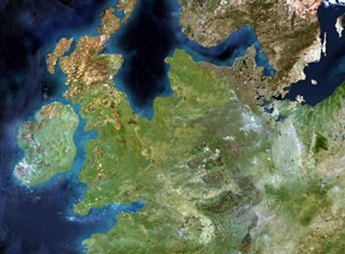
The myths of lost Atlantis are Egyptian. One of the oldest known example of archeoastronomy with stone circles (Nabta Playa, Nubian Desert) is in pre-sand Egypt, dated to the fifth Millennium BC. – 2000 years before Stonehenge. This temple of the stars demonstrates the sky ‘moves’ in a predictable long-term cycle. An alignment with Sirius in 6088 BC and other alignments dated to 6270 suggest an estimated date 1500 years earlier. The site was used as a necropolis in the Saharan wet period of pre-history, roughly 11,000 – 5,000 years ago when the playa bloomed. The area became arid 4,800 years ago when the monsoon returned to the equator. Egyptian culture moved to the Nile Valley.
The circle of Precession is called the “circle of Sidi” or Circle of Seven, which is also a name for Stonehenge. The Welsh name for Zodiac or ecliptic is ‘Sidydd.’ ‘Sidi’ is the Arabic honorific, ‘Lord,’ ‘master,’ or ‘saint.’ It refers to the seven (periods of) the pole stars. Seven shifting positions are also the model for the stellar crown of seven stones. Over the cycle of Precession constellations have “sunk” below the horizon in the Abyss of the heavens.
In the Dragon lineage the astronomical mythos came down to Earth as seers and overlords – the Siddhe, who described how to live in harmony with nature within the divine scheme of things. Galactic alignment of Earth with the core of the Milky Way is the long lost zero point of the precessional cycle. Precession defines the Great Year of circulation about the signs of the Zodiac. There is some evidence the Druids even placed a taboo on their people against speaking the names of the sacred planets, mandating euphemisms, such as ‘brightness’ for the Moon.
There were three cataclysms, or major geologic changes, in Earth's recent history. The first, around 20,200 BC, was declared as the starting point for reasons which are not clear and by people now unknown. The glaciers started to melt. A second geologic change occurred around 12,200 BC. There, again, was a sudden warming, causing more glaciers to melt. Many people died.
A third geologic change occurred around 8100 BC. This marked the end of the ice age with a climactic optimum. There was a sudden rise in sea level, drowning many coastal cities, many mammals became extinct, and most of the world's population died. Britain lost her solid connection with the mainland when lower lying Doggerland finally disappeared beneath the waves, severing her from the continent. These epic disasters came down as legends of pre-diluvial Atlantis and sent surviving megalithic inhabitants on nomadic treks across Europe, the Middle East, toward China and India and back again via Gaul, Egypt and Spain.
Egyptian beliefs were in Druid practice, but Egypt was originally a colony of Atlantis, the true source of the Druids. Although the Scythians of later ages were originally affiliated with the Megalithic Arya, some of their number became spiritually and morally corrupt. Today, a few mainstream historians and archeologists hesitatingly accept that Western "Celts" (sic) had settlements in the Middle and Far East. This is because these migrations were relatively late, historically speaking. They date from approximately 600 BC onward. The Hyksos/Atonists were originally Scythians from the West who migrated through Egypt.
The Ouroboros that bites its own tail can be traced back to ancient Egypt, circa 1,600 BCE. Also the serpent entwined around the (serpent's) egg, was a symbol common to the Egyptians and the Druids. It referred to the creation of the Universe, Precession and the Milky Way. The World egg also known as the Serpent’s Egg, or the Druid’s Egg is a potent symbol of the union of masculine and feminine. It depicts the creation of the World from these two aspects of divinity and reminds us that we contain both male and female within.
Survivors of drowned islands knew the nature of cataclysm. Arguably, according to de Vere's research, the Atlanteans were antediluvian Dragon gods of ancient proto-Scythia driven from their homeland by the Black Sea flood, now scientifically dated to 6,900 years ago when vast ice sheets melted inundating their freshwater lake with seawater. This led to mass migrations as the climate re-adjusted. Modern research suggests migrations went both ways many times and cultures mixed, even while the royal bloodline persisted.
Legend says, "One group consisting of seven males, three females and one child, established an Atlantean colony on Iona. They built a small library for ancient sacred works. Around the library which they called their ‘heart seed', they built a strong, almost fortress like Temple." They called Iona Aberuk, or "distant place of the heart'." It is said the Hyperboreans called it Luma or "bright land." The priestesses on Iona called themselves the Priestesses of Ank, or ‘sacred well of life'. Ank is strongly suggestive of the Egyptian Ankh, symbol of life. Ionian priestesses were the basis for the Celtic legends concerning sanctuaries of ‘Lady of the Lake' type anima women who regenerate the male psyche and often his physical form as well.
Descriptions of activities on Iona throughout history echo Egyptian forebearers. The Egyptians had several classes of priesthood, but the Sesh-Per-Ankh were the scribes of the House of Life. These, too, were frequently associated with magical knowledge because of their connection with the sacred texts. The scribes worked largely within the Per-Ankh copying temple texts. They were considered to be very wise and scholarly. The scribes were also considered healers, possessing medical knowledge. French Egyptologist, Dr. Serge Sauneron describes the activities of the scribes in the Per-Ankh:
"The main activities in the house of life consisted in preparing the religious works necessary to the cult, in recopying the old manuscripts, in correcting errors, in completing the gaps and passages short of lines; they developed the texts of theology or of liturgy particular to each temple; they prepared the magic books of protection, the astronomical tables; they recopied a thousand times, versions of the Book of the Dead; they discussed with ardor, between copying sessions, philosophical and religious problems, without neglecting medicine and literary activities . . . For everything was not just mechanical copying, in these studies; sometimes an original text, sometimes a theosophical exposition would be drawn up following meditation or the exchange of fruitful views . . . Some of the finest spiritual or ethical texts we possess were stimulated by the reflections and convictions of some obscure scribe whose name will never be known to us . . ." (Sauneron 1960.136)
The migrations of Atlantis, Egypt, Scythia, Ireland, Scotland and Iona bring us full circle in the Celtic cycle. We’ve seen the Cosmos in a fractal grain of Iona’s sand. On Iona, the sANKHtuary, every stone could be a Philosopher’s Stone. The vision of the reborn spirit within us is that of “heaven spread upon Earth.”
The circle of Precession is called the “circle of Sidi” or Circle of Seven, which is also a name for Stonehenge. The Welsh name for Zodiac or ecliptic is ‘Sidydd.’ ‘Sidi’ is the Arabic honorific, ‘Lord,’ ‘master,’ or ‘saint.’ It refers to the seven (periods of) the pole stars. Seven shifting positions are also the model for the stellar crown of seven stones. Over the cycle of Precession constellations have “sunk” below the horizon in the Abyss of the heavens.
In the Dragon lineage the astronomical mythos came down to Earth as seers and overlords – the Siddhe, who described how to live in harmony with nature within the divine scheme of things. Galactic alignment of Earth with the core of the Milky Way is the long lost zero point of the precessional cycle. Precession defines the Great Year of circulation about the signs of the Zodiac. There is some evidence the Druids even placed a taboo on their people against speaking the names of the sacred planets, mandating euphemisms, such as ‘brightness’ for the Moon.
There were three cataclysms, or major geologic changes, in Earth's recent history. The first, around 20,200 BC, was declared as the starting point for reasons which are not clear and by people now unknown. The glaciers started to melt. A second geologic change occurred around 12,200 BC. There, again, was a sudden warming, causing more glaciers to melt. Many people died.
A third geologic change occurred around 8100 BC. This marked the end of the ice age with a climactic optimum. There was a sudden rise in sea level, drowning many coastal cities, many mammals became extinct, and most of the world's population died. Britain lost her solid connection with the mainland when lower lying Doggerland finally disappeared beneath the waves, severing her from the continent. These epic disasters came down as legends of pre-diluvial Atlantis and sent surviving megalithic inhabitants on nomadic treks across Europe, the Middle East, toward China and India and back again via Gaul, Egypt and Spain.
Egyptian beliefs were in Druid practice, but Egypt was originally a colony of Atlantis, the true source of the Druids. Although the Scythians of later ages were originally affiliated with the Megalithic Arya, some of their number became spiritually and morally corrupt. Today, a few mainstream historians and archeologists hesitatingly accept that Western "Celts" (sic) had settlements in the Middle and Far East. This is because these migrations were relatively late, historically speaking. They date from approximately 600 BC onward. The Hyksos/Atonists were originally Scythians from the West who migrated through Egypt.
The Ouroboros that bites its own tail can be traced back to ancient Egypt, circa 1,600 BCE. Also the serpent entwined around the (serpent's) egg, was a symbol common to the Egyptians and the Druids. It referred to the creation of the Universe, Precession and the Milky Way. The World egg also known as the Serpent’s Egg, or the Druid’s Egg is a potent symbol of the union of masculine and feminine. It depicts the creation of the World from these two aspects of divinity and reminds us that we contain both male and female within.
Survivors of drowned islands knew the nature of cataclysm. Arguably, according to de Vere's research, the Atlanteans were antediluvian Dragon gods of ancient proto-Scythia driven from their homeland by the Black Sea flood, now scientifically dated to 6,900 years ago when vast ice sheets melted inundating their freshwater lake with seawater. This led to mass migrations as the climate re-adjusted. Modern research suggests migrations went both ways many times and cultures mixed, even while the royal bloodline persisted.
Legend says, "One group consisting of seven males, three females and one child, established an Atlantean colony on Iona. They built a small library for ancient sacred works. Around the library which they called their ‘heart seed', they built a strong, almost fortress like Temple." They called Iona Aberuk, or "distant place of the heart'." It is said the Hyperboreans called it Luma or "bright land." The priestesses on Iona called themselves the Priestesses of Ank, or ‘sacred well of life'. Ank is strongly suggestive of the Egyptian Ankh, symbol of life. Ionian priestesses were the basis for the Celtic legends concerning sanctuaries of ‘Lady of the Lake' type anima women who regenerate the male psyche and often his physical form as well.
Descriptions of activities on Iona throughout history echo Egyptian forebearers. The Egyptians had several classes of priesthood, but the Sesh-Per-Ankh were the scribes of the House of Life. These, too, were frequently associated with magical knowledge because of their connection with the sacred texts. The scribes worked largely within the Per-Ankh copying temple texts. They were considered to be very wise and scholarly. The scribes were also considered healers, possessing medical knowledge. French Egyptologist, Dr. Serge Sauneron describes the activities of the scribes in the Per-Ankh:
"The main activities in the house of life consisted in preparing the religious works necessary to the cult, in recopying the old manuscripts, in correcting errors, in completing the gaps and passages short of lines; they developed the texts of theology or of liturgy particular to each temple; they prepared the magic books of protection, the astronomical tables; they recopied a thousand times, versions of the Book of the Dead; they discussed with ardor, between copying sessions, philosophical and religious problems, without neglecting medicine and literary activities . . . For everything was not just mechanical copying, in these studies; sometimes an original text, sometimes a theosophical exposition would be drawn up following meditation or the exchange of fruitful views . . . Some of the finest spiritual or ethical texts we possess were stimulated by the reflections and convictions of some obscure scribe whose name will never be known to us . . ." (Sauneron 1960.136)
The migrations of Atlantis, Egypt, Scythia, Ireland, Scotland and Iona bring us full circle in the Celtic cycle. We’ve seen the Cosmos in a fractal grain of Iona’s sand. On Iona, the sANKHtuary, every stone could be a Philosopher’s Stone. The vision of the reborn spirit within us is that of “heaven spread upon Earth.”
Celtic cross
A Celtic cross places a circle around the arms of a Latin cross. A cross within a circle or cross with multiple rays like spokes from a wheel is an emblem of the sun and is found on many stone carvings and objects prior to Christianity. The sun cross became the Celtic cross, uniting Christ with the luminous and cosmic power of the sun. Today, there are 60 to 70 remaining Irish High Crosses.The average height is over 10 feet. A few (Monasterboice) are as tall as 22 feet. Including all the British Isles, about 300 high cross monuments remain out of the several thousand. Many were destroyed during anti-Catholic periods. The large stone crosses developed from different influences, Egyptian and Armenian as well as Celtic. Biblical and local scenes were carved on the fairly soft (mostly sandstone) stone crosses. These crosses are generally found on or near monastic sites. Irish High crosses were used to mark boundaries, for gatherings and instruction, and for prayer. Some crosses request a prayer for the person who donated the cross. Originally, like illuminated manuscripts, the crosses were most likely brightly painted.
A Celtic cross places a circle around the arms of a Latin cross. A cross within a circle or cross with multiple rays like spokes from a wheel is an emblem of the sun and is found on many stone carvings and objects prior to Christianity. The sun cross became the Celtic cross, uniting Christ with the luminous and cosmic power of the sun. Today, there are 60 to 70 remaining Irish High Crosses.The average height is over 10 feet. A few (Monasterboice) are as tall as 22 feet. Including all the British Isles, about 300 high cross monuments remain out of the several thousand. Many were destroyed during anti-Catholic periods. The large stone crosses developed from different influences, Egyptian and Armenian as well as Celtic. Biblical and local scenes were carved on the fairly soft (mostly sandstone) stone crosses. These crosses are generally found on or near monastic sites. Irish High crosses were used to mark boundaries, for gatherings and instruction, and for prayer. Some crosses request a prayer for the person who donated the cross. Originally, like illuminated manuscripts, the crosses were most likely brightly painted.
REFERENCES
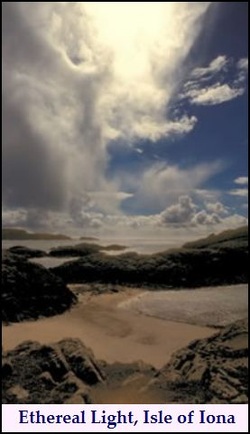
de Vere, Nicholas (1985-2004), The Dragon Legacy, San Diego, California; The Book Tree.
de Vere, Nicholas, (2005-2010), The Dragon Cede, San Diego, California; The Book Tree.
Dunford, Barry, “Iona, Sacred Isle of the West,” http://www.sacredconnections.co.uk/holyland/iona.htm
Dunford, Barry, “The Mystery of the Mother Church,” http://www.sacredconnections.co.uk/holyland/motherchurch.htm
Ellis, Peter Berresford, A Brief History of the Druids http://books.google.com/books?id=PIXAREdVI_QC&printsec=frontcover#v=onepage&q&f=false
Gardner, Laurence (2003), “Realm of the Ring Lords,” Nexus Magazine.
Gardner, Laurence (2002), Bloodline of the Holy Grail, Fair Winds Press; Rev Exp edition.
- Bloodline of The Holy Grail: The Hidden Lineage of Jesus Revealed (1996) (ISBN 1852308702)
- Genesis of the Grail Kings: The Astonishing Story of the Ancient Bloodline of Christ and the True Heritage of the Holy Grail (1999) (ISBN 0553817744)
- Illustrated Bloodline of the Holy Grail (2000) (ISBN 1862047707)
- Realm of The Ring Lords: The Ancient Legacy of the Ring and the Grail (2003) (ISBN 1931412146)
- Lost Secrets of the Sacred Ark: Amazing Revelations of the Incredible Power of Gold (2004) (ISBN 0007142951)
- The Magdalene Legacy: The Jesus and Mary Bloodline Conspiracy (2005) (ISBN 0007200854)
- The Shadow of Solomon: The Lost Secret of the Freemasons Revealed (2005) (ISBN 1578634040)
- The Grail Enigma: The Hidden Heirs of Jesus and Mary Magdalene (2008) (ISBN 0007266944)
Menzies, Lucy (1920), Saint Columba of Iona.
Miller, Iona (2010), “Iona Mystic Isle.” http://ionamiller.weebly.com/iona-mystic-island.html
Sauneron, Serge (1957-2000), The Priests of Ancient Egypt,” Cornell University.
Tsarion, Michael (2007), Irish Origins of Civilization, Taroscopes: http://www.irishoriginsofcivilization.com/irishoriginsexcerpts/book1_chap1.html
©2010 Iona Miller is a nonfiction writer for the academic and popular press, hypnotherapist (ACHE) and multimedia artist. She has pursued a lifelong interest in esoterics and mysticism. Her conspirituality work is an omni-sensory fusion of intelligence, science-art, new physics and emergent paradigm shift, melding many social issues into a new view of society. She is interested in the effects of doctrines from religion, science, psychology, and the arts. Website: http://ionamiller.weebly.com
Coming Attractions - The End Time, Jeremy Irons as St. Columba
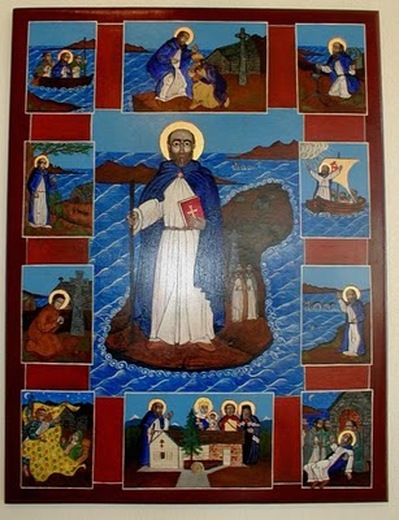
SINNER AND SAINT; As Jeremy Irons prepares to play him in a movie, the violent story of Columba - and of how he journeyed from taking lives to saving souls. SINNER AND SAINT; As Jeremy Irons prepares to play him in a movie, the violent story of Columba - and of how he journeyed from taking lives to saving souls.
Byline: by Turtle Bunbury
EVEN as he ran, Columba knew he was too late. From the entrance to the abbey, he saw the glinting daggers plunge into the young prince's heart and throat. The boy died quickly, his blood seeping into the green pastures of Kells Abbey. Columba, the abbot who closed his eyes, knew this was only the beginning of a terrible war which would claim more than 3,000 souls.
Of all the hundreds of saints that Ireland has produced, none can hold a match to Saint Columba for sheer drama. His epic story has entranced people ever since his first biography was etched with an inky feather back in the 7th century. By then his name was already legendary throughout the Christian world. He would go on to become the key saint of floods, poets, bookbinders and, most notably, of Scotland.
By the 16th century, he was venerated by Lutheran, Anglican, Orthodox and Catholic churches alike.But though his name means 'dove of the Church', this gentle priest hid a dark past. And the decades he spent in Scotland creating a centre of worship and learning that lit a beacon to guide Europe through the Dark Ages were, in reality, a self-imposed atonement for the sins that saw him banished from Ireland.
Now, more than 1,400 years later the story of Ireland's 'Royal Saint' is headed for the big screen with a movie called The End Time. Jeremy Irons has signed up to star as the magnetic Donegal missionary, with filming to begin in Ireland and Scotland next spring. The End Time will be directed by Bafta award-winning Norman Stone - who recently directed the biopic of Florence Nightingale.
Stone says the film will be a 'warts and all' examination of Columba's life. 'I see him as a man of incredible faith, integrity and strength, but, at times, flawed,' says the director. 'He was not a saintly saint and this film will not a saintly saint and this film will be more a character study and a political thriller than a Christian epic. Columba will not wear a halo.'
Certainly, in his early life Columba did not deserve one. Born on the grassy shores of Lough Gartan, Co. Donegal, Columba was a prince of the royal house of O'Neill. His father, Prince Felim, was a great-grandson of Niall of the Nine Hostages, the iconic 5th century High King of Ireland High King of Ireland (Irish: Ard Rí na hÉireann) refers to legendary, pagan kings of Tara. It also refers to later kings, who were, depending on the period, either the most powerful king of their day, or, in later times, exercised authority over most of Ireland. . The baby was named Crimthann but later changed his name to Colmcille and eventually Columba.
His date of birth is stated as December 7, 521, 28 years after the death of St Patrick. Owing to the older man's efforts, Christianity had taken a firm root in Ireland and Irish monasteries were considered to be world leaders in faith.
Young Columba was educated in the monastic school at Moville, on the shores of Strangford Lough in Co. Down, under the tutelage of St Finnian. He was described as a youth of 'tremendous energy and a vigorous personality', who showed great academic ability. After further training, he entered Clonard Abbey. Probably the finest Christian school in Ireland at this time, Clonard sprawled upon the banks of the River Boyne in Co. Meath and had as many as 3,000 students.
The tall , blond Ulsterman excelled at Clonard, becoming one of the Abbey's inner circle, later known as the Twelve Apostles of Ireland The Twelve Apostles of Ireland were twelve Irish clergymen of the sixth century who went to study at the Clonard monastic school in Meath:
His first monastery was built in an oak forest on the banks of the River Foyle on some land gifted to him by King Aed of Connaught. The settlement, upon which the Long Tower Church stands today, was later called Doire Colmcille, and is better known as Derry. He is also credited with founding monasteries at Kells, Durrow, Clonmore, Lambay Island, Swords, Moone, Drumcliffe and Glencolumbcille, close to his place of birth.
Despite his obvious devotion to the Church, Columba's noble family still expected him to take up his rightful place in the royal lineage. The House of O'Neill invited him to stand as their candidate for the High Kingship of Ireland.
He shocked them by declining, and his pagan cousin, Diarmuid Mac Cerbhaill, was nominated instead. A warrior, Diarmuid was enraged that he was his family's second choice after a lowly priest. Though he was duly elected High King of Ireland, he held a deep-seated bitterness for his Christian cousin.
Columba's travels brought him to Dromin, Co. Louth, where his old mentor Finnian was now a bishop. While browsing through Finnian's library, Columba came upon a particularly rare book of Latin psalms written by St Martin of Tours Mar·tin of Tours , Saint a.d. 316?-397?.
French prelate considered the patron saint of France. . Eager to have his own copy of this sacred work, the priest surreptitiously sur·rep·ti·tious
adj.
1. Obtained, done, or made by clandestine or stealthy means.
2. Acting with or marked by stealth. See Synonyms at secret. slipped into the scriptorium scrip·to·ri·um
n. pl. scrip·to·ri·ums or scrip·to·ri·a
A room in a monastery set aside for the copying, writing, or illuminating of manuscripts and records. and created an exact replica.
A furious Finnian demanded the book back, claiming it was property of the Church. Columba refused, reasoning that making copies of such work was vital to the spread of Christianity.
The matter went to the High Court in Tara where the judge was none other than Diarmuid, High King of Ireland, who had an axe to grind Axe to grind
Used in context of general equities. Involvement in a security, whether through a position, order, or inquiry. with his cousin. With cauldron-stirring druids whispering in his ear, in what is now regarded as the world's first dispute over copyright infringement, the monarch ruled 'To every cow her calf, therefore to every book its copy'.Columba had to hand it over.
The decision ignited a bitter row amongst the O'Neills. The clan was split between the feuding cousins - and everyone was looking for an excuse to settle it by the sword This article is about the fantasy novel by Mercedes Lackey. For other uses, see By the Sword (disambiguation).
By the Sword is the name of a 1991 fantasy novel by Mercedes Lackey. .
In 561, during a hurling match at the annual Tailteann Games in Co. Meath, a row broke out on the pitch. Prince Cunan - son of King Aed of Connaught and another cousin of Columba's - dealt a deadly blow to the son of Diarmuid's royal steward. Realising what he had done, Cunan fled by horse to Columba's abbey in Kells.
DIARMUID and his men tracked the fugitive prince down, stormed the abbey and executed him. Standing helplessly by as the daggers were driven into his young cousin's heart, Columba was incensed that they had breached the sanctity of the Church. With the boy's grieving father, King Aed, he made a pact to get rid of Diarmuid - and mobilised an army.
Diarmuid's forces marched to meet them at Cul Dreimhne (Cooldrevny) in Co. Sligo. As they fought, the warrior priest cursed his foes and, with arms outstretched, loudly implored God to smite those who had 'taken his living'.At the end of a vicious battle, over 3,000 men lay dead. While Aed and his army celebrated victory over Diarmuid, Columba's Christian superiors were distraught at the loss of life. A synod of clerics and scholars gathered to have him excommunicated. St Brendan of Birr birr 1
n.
1. A whirring sound.
2. Strong forward momentum; driving force.
intr.v. birred, birr·ing, birrs
To make a whirring sound. , another of the Twelve Apostles, interjected on his behalf and negotiated a compromise.
Columba would go into exile in Scotland, where he vowed to spend the rest of his life gaining as many souls for Christ as had been slain in the battle of Cul Dreimhne.
He set sail in a wicker currach cur·rach also cur·ragh
n. Scots & Irish
A coracle.
[Middle English currok, from Middle Irish curach; see coracle.] with 12 friends. They landed on the island of Iona on the west coast of Scotland on the eve On the Eve (Накануне in Russian) is the third novel by famous Russian writer Ivan Turgenev, best known for his short stories and the novel Fathers and Sons. of Pentecost in the spring of 563. Thirteen years would pass before Columba returned to his native soil.
Columba and his men built a monastic settlement on Iona, complete with church, refectory and cells, all constructed from wattle wattle, in botany: see acacia. and planks. Under Columba's guidance, the island became the epicentre epicentre
Point on the surface of the Earth that is directly above the source (or focus) of an earthquake. There the effects of the earthquake usually are most severe. See also seismology. for an early Christian renaissance as its monks began to churn out books, art, music and, above all, eager young missionaries.
From Iona, Columba ran an extraordinary network, dispatching monks to spread the word of the Church across Pictish Scotland.This evangelising came at a critical moment as Europe, still reeling from the collapse of the Roman Empire, was sinking into the Dark Ages.
In 574, Columba scored his greatest victory when he ordained Aedhan, pagan king of Dalriada, or western Scotland. This is the earliest recorded consecration of a king in Britain. Columba was a skilled diplomat and became a Scottish kingmaker king·mak·er
n.
One who has the political power to influence the selection of a candidate for high public office. king . He also had a useful arsenal of miracles up his sleeve. For instance, when he arrived at the royal palace of Brude, one of the most powerful of the Pictish Kings, near Inverness, the gates were bolted against him. Columba made the sign of the cross and the bolts flew open. Brude was duly intimidated into throwing in his lot with the Christians.
In 575, Columba returned to Ireland to attend the synod of Druim Ceat, near Derry, where he was welcomed with open arms by those who had cast him out over a decade before. He became a champion of Ireland's bards and poets, and his diplomatic skills were again called upon to settle disputes between feuding kingdoms. A renowned man of letters and hymn writer, he is credited with having transcribed over 300 books, including The Book Of Durrow The Book of Durrow (Dublin, Trinity College Library, MS A. 4. 5. (57)) is a 7th century illuminated manuscript in the Insular style made either at Durrow Abbey near Durrow in County Offaly Ireland, or in Northumbria in Northern England, with modern and traditional scholarship .
In 592, as the Annals put it, Columba 'went to the angels from his body, after seven years and 70'. He died on Iona and was buried by his monks in the abbey he created. Two centuries later, after a series of devastating Viking raids, the monks of Iona fled. Many settled in Kells, the abbey Columba founded in Co. Meath, where they completed the Book of Kells Book of Kells: see Ceanannus Mór. Book of Kells Illuminated manuscript version of the four Gospels, c. late 8th–early 9th century. , a masterpiece of Irish Celtic symbols, art and literature. Columba was disinterred and reputedly reburied in Downpatrick, Co. Down, along with St Patrick and St Brigid.
Norman Stone says that The End Game will explore Columba's role in spreading Christianity. 'It's the whole idea of just how precarious the future of Christianity was at that time when druids still had such power and Europe was entering the Dark Ages. We are talking about a world 500 years before Braveheart, so it is a fascinating period and it has never been tackled on the big screen.'
CAPTION(S):
'Strong yet flawed': St Columba
Hollywood hit: Jeremy Irons will play St Columba in The End Time COPYRIGHT 2010 The Daily Mail The Daily Mail
No portion of this article can be reproduced without the express written permission from the copyright holder. Copyright 2010 Gale, Cengage Learning. All rights reserved.
Byline: by Turtle Bunbury
EVEN as he ran, Columba knew he was too late. From the entrance to the abbey, he saw the glinting daggers plunge into the young prince's heart and throat. The boy died quickly, his blood seeping into the green pastures of Kells Abbey. Columba, the abbot who closed his eyes, knew this was only the beginning of a terrible war which would claim more than 3,000 souls.
Of all the hundreds of saints that Ireland has produced, none can hold a match to Saint Columba for sheer drama. His epic story has entranced people ever since his first biography was etched with an inky feather back in the 7th century. By then his name was already legendary throughout the Christian world. He would go on to become the key saint of floods, poets, bookbinders and, most notably, of Scotland.
By the 16th century, he was venerated by Lutheran, Anglican, Orthodox and Catholic churches alike.But though his name means 'dove of the Church', this gentle priest hid a dark past. And the decades he spent in Scotland creating a centre of worship and learning that lit a beacon to guide Europe through the Dark Ages were, in reality, a self-imposed atonement for the sins that saw him banished from Ireland.
Now, more than 1,400 years later the story of Ireland's 'Royal Saint' is headed for the big screen with a movie called The End Time. Jeremy Irons has signed up to star as the magnetic Donegal missionary, with filming to begin in Ireland and Scotland next spring. The End Time will be directed by Bafta award-winning Norman Stone - who recently directed the biopic of Florence Nightingale.
Stone says the film will be a 'warts and all' examination of Columba's life. 'I see him as a man of incredible faith, integrity and strength, but, at times, flawed,' says the director. 'He was not a saintly saint and this film will not a saintly saint and this film will be more a character study and a political thriller than a Christian epic. Columba will not wear a halo.'
Certainly, in his early life Columba did not deserve one. Born on the grassy shores of Lough Gartan, Co. Donegal, Columba was a prince of the royal house of O'Neill. His father, Prince Felim, was a great-grandson of Niall of the Nine Hostages, the iconic 5th century High King of Ireland High King of Ireland (Irish: Ard Rí na hÉireann) refers to legendary, pagan kings of Tara. It also refers to later kings, who were, depending on the period, either the most powerful king of their day, or, in later times, exercised authority over most of Ireland. . The baby was named Crimthann but later changed his name to Colmcille and eventually Columba.
His date of birth is stated as December 7, 521, 28 years after the death of St Patrick. Owing to the older man's efforts, Christianity had taken a firm root in Ireland and Irish monasteries were considered to be world leaders in faith.
Young Columba was educated in the monastic school at Moville, on the shores of Strangford Lough in Co. Down, under the tutelage of St Finnian. He was described as a youth of 'tremendous energy and a vigorous personality', who showed great academic ability. After further training, he entered Clonard Abbey. Probably the finest Christian school in Ireland at this time, Clonard sprawled upon the banks of the River Boyne in Co. Meath and had as many as 3,000 students.
The tall , blond Ulsterman excelled at Clonard, becoming one of the Abbey's inner circle, later known as the Twelve Apostles of Ireland The Twelve Apostles of Ireland were twelve Irish clergymen of the sixth century who went to study at the Clonard monastic school in Meath:
- Saint Ciaran of Saighir (Seir-Kieran)
- Saint Ciaran of Clonmacnoise
- Saint Brendan of Birr
- Saint Brendan of Clonfert
His first monastery was built in an oak forest on the banks of the River Foyle on some land gifted to him by King Aed of Connaught. The settlement, upon which the Long Tower Church stands today, was later called Doire Colmcille, and is better known as Derry. He is also credited with founding monasteries at Kells, Durrow, Clonmore, Lambay Island, Swords, Moone, Drumcliffe and Glencolumbcille, close to his place of birth.
Despite his obvious devotion to the Church, Columba's noble family still expected him to take up his rightful place in the royal lineage. The House of O'Neill invited him to stand as their candidate for the High Kingship of Ireland.
He shocked them by declining, and his pagan cousin, Diarmuid Mac Cerbhaill, was nominated instead. A warrior, Diarmuid was enraged that he was his family's second choice after a lowly priest. Though he was duly elected High King of Ireland, he held a deep-seated bitterness for his Christian cousin.
Columba's travels brought him to Dromin, Co. Louth, where his old mentor Finnian was now a bishop. While browsing through Finnian's library, Columba came upon a particularly rare book of Latin psalms written by St Martin of Tours Mar·tin of Tours , Saint a.d. 316?-397?.
French prelate considered the patron saint of France. . Eager to have his own copy of this sacred work, the priest surreptitiously sur·rep·ti·tious
adj.
1. Obtained, done, or made by clandestine or stealthy means.
2. Acting with or marked by stealth. See Synonyms at secret. slipped into the scriptorium scrip·to·ri·um
n. pl. scrip·to·ri·ums or scrip·to·ri·a
A room in a monastery set aside for the copying, writing, or illuminating of manuscripts and records. and created an exact replica.
A furious Finnian demanded the book back, claiming it was property of the Church. Columba refused, reasoning that making copies of such work was vital to the spread of Christianity.
The matter went to the High Court in Tara where the judge was none other than Diarmuid, High King of Ireland, who had an axe to grind Axe to grind
Used in context of general equities. Involvement in a security, whether through a position, order, or inquiry. with his cousin. With cauldron-stirring druids whispering in his ear, in what is now regarded as the world's first dispute over copyright infringement, the monarch ruled 'To every cow her calf, therefore to every book its copy'.Columba had to hand it over.
The decision ignited a bitter row amongst the O'Neills. The clan was split between the feuding cousins - and everyone was looking for an excuse to settle it by the sword This article is about the fantasy novel by Mercedes Lackey. For other uses, see By the Sword (disambiguation).
By the Sword is the name of a 1991 fantasy novel by Mercedes Lackey. .
In 561, during a hurling match at the annual Tailteann Games in Co. Meath, a row broke out on the pitch. Prince Cunan - son of King Aed of Connaught and another cousin of Columba's - dealt a deadly blow to the son of Diarmuid's royal steward. Realising what he had done, Cunan fled by horse to Columba's abbey in Kells.
DIARMUID and his men tracked the fugitive prince down, stormed the abbey and executed him. Standing helplessly by as the daggers were driven into his young cousin's heart, Columba was incensed that they had breached the sanctity of the Church. With the boy's grieving father, King Aed, he made a pact to get rid of Diarmuid - and mobilised an army.
Diarmuid's forces marched to meet them at Cul Dreimhne (Cooldrevny) in Co. Sligo. As they fought, the warrior priest cursed his foes and, with arms outstretched, loudly implored God to smite those who had 'taken his living'.At the end of a vicious battle, over 3,000 men lay dead. While Aed and his army celebrated victory over Diarmuid, Columba's Christian superiors were distraught at the loss of life. A synod of clerics and scholars gathered to have him excommunicated. St Brendan of Birr birr 1
n.
1. A whirring sound.
2. Strong forward momentum; driving force.
intr.v. birred, birr·ing, birrs
To make a whirring sound. , another of the Twelve Apostles, interjected on his behalf and negotiated a compromise.
Columba would go into exile in Scotland, where he vowed to spend the rest of his life gaining as many souls for Christ as had been slain in the battle of Cul Dreimhne.
He set sail in a wicker currach cur·rach also cur·ragh
n. Scots & Irish
A coracle.
[Middle English currok, from Middle Irish curach; see coracle.] with 12 friends. They landed on the island of Iona on the west coast of Scotland on the eve On the Eve (Накануне in Russian) is the third novel by famous Russian writer Ivan Turgenev, best known for his short stories and the novel Fathers and Sons. of Pentecost in the spring of 563. Thirteen years would pass before Columba returned to his native soil.
Columba and his men built a monastic settlement on Iona, complete with church, refectory and cells, all constructed from wattle wattle, in botany: see acacia. and planks. Under Columba's guidance, the island became the epicentre epicentre
Point on the surface of the Earth that is directly above the source (or focus) of an earthquake. There the effects of the earthquake usually are most severe. See also seismology. for an early Christian renaissance as its monks began to churn out books, art, music and, above all, eager young missionaries.
From Iona, Columba ran an extraordinary network, dispatching monks to spread the word of the Church across Pictish Scotland.This evangelising came at a critical moment as Europe, still reeling from the collapse of the Roman Empire, was sinking into the Dark Ages.
In 574, Columba scored his greatest victory when he ordained Aedhan, pagan king of Dalriada, or western Scotland. This is the earliest recorded consecration of a king in Britain. Columba was a skilled diplomat and became a Scottish kingmaker king·mak·er
n.
One who has the political power to influence the selection of a candidate for high public office. king . He also had a useful arsenal of miracles up his sleeve. For instance, when he arrived at the royal palace of Brude, one of the most powerful of the Pictish Kings, near Inverness, the gates were bolted against him. Columba made the sign of the cross and the bolts flew open. Brude was duly intimidated into throwing in his lot with the Christians.
In 575, Columba returned to Ireland to attend the synod of Druim Ceat, near Derry, where he was welcomed with open arms by those who had cast him out over a decade before. He became a champion of Ireland's bards and poets, and his diplomatic skills were again called upon to settle disputes between feuding kingdoms. A renowned man of letters and hymn writer, he is credited with having transcribed over 300 books, including The Book Of Durrow The Book of Durrow (Dublin, Trinity College Library, MS A. 4. 5. (57)) is a 7th century illuminated manuscript in the Insular style made either at Durrow Abbey near Durrow in County Offaly Ireland, or in Northumbria in Northern England, with modern and traditional scholarship .
In 592, as the Annals put it, Columba 'went to the angels from his body, after seven years and 70'. He died on Iona and was buried by his monks in the abbey he created. Two centuries later, after a series of devastating Viking raids, the monks of Iona fled. Many settled in Kells, the abbey Columba founded in Co. Meath, where they completed the Book of Kells Book of Kells: see Ceanannus Mór. Book of Kells Illuminated manuscript version of the four Gospels, c. late 8th–early 9th century. , a masterpiece of Irish Celtic symbols, art and literature. Columba was disinterred and reputedly reburied in Downpatrick, Co. Down, along with St Patrick and St Brigid.
Norman Stone says that The End Game will explore Columba's role in spreading Christianity. 'It's the whole idea of just how precarious the future of Christianity was at that time when druids still had such power and Europe was entering the Dark Ages. We are talking about a world 500 years before Braveheart, so it is a fascinating period and it has never been tackled on the big screen.'
CAPTION(S):
'Strong yet flawed': St Columba
Hollywood hit: Jeremy Irons will play St Columba in The End Time COPYRIGHT 2010 The Daily Mail The Daily Mail
No portion of this article can be reproduced without the express written permission from the copyright holder. Copyright 2010 Gale, Cengage Learning. All rights reserved.
Lost Tribes
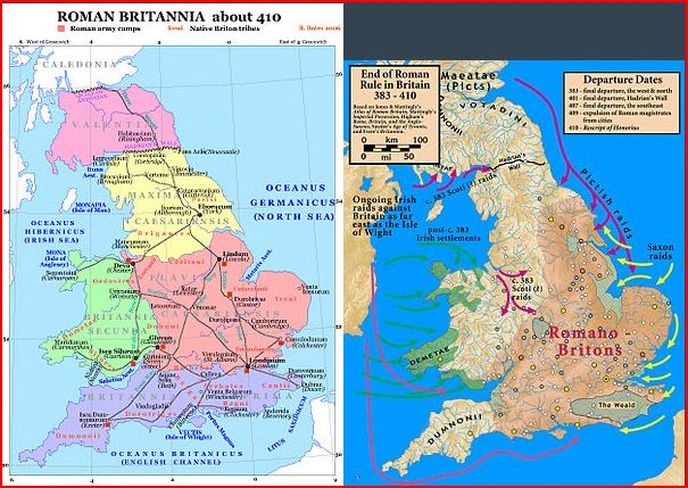
Would you believe these are you (Isaiah says; to the "isles afar off")? Are they descendents of the British Isles, Ireland, the countries of northwest Europe, the United States and even Japan? In an irony to Jewish history, could the tribe of Dan have gone to Greece and later to Rome? Could descendents of Dan have actually been involved with all the holocausts of Jewish history (Greek, Roman, Inquisition and Nazi Germany)?
One important link/key is the term Scythians (Celts); "the people who dwell in booths".
Did the prophet Jeremiah (a Chief of Iber) die in Ireland?
Did he travel there in 583-560 BC from Egypt around the same time of the destruction of Jerusalem, with: the scribe Baruch, Ebed-Melech, Tea Tephi (daughter of Zedekiah & heir to the throne-line of Pharez), and the son of the king of Ireland who had been in Jerusalem at the time of the siege? Did Jeremiah come to Ireland to build the nation Israel in the Isles of the West and to plant the royal line of David upon Israels throne in the person of Zedekiahs daughter, Tea Tephi? Tea Tephi is the name of the most celebrated queen in early Irish history. With her the lion came into Irish heraldry, an emblem of the Israelites, but especially of the tribe of Judah. With Tea Tephi also a most remarkable 400 pound stone came to Ireland called the Lia Fail, or stone wonderful, or Stone of Scone upon which the Irish line of kings were crowned until about 500 A.D. Thereafter it was carried to Scotland and used as coronation stone there till 1296 A.D. Then Edward I carried it to Westminster Abbey where it has been ever since, until just recently when it was returned to Scotland, as the Coronation Stone of Great Britain.
Tea Tephi married the Irish monarch, Eiochaid, the Heremonn, thus joining the Pharez and Zarah branches of Judahs royal line, and from them through the Irish and Scotch line of kings one can trace the descent to George VI and show that Davids line did not lapse for Yahweh keep His covenant of salt. (2 Chronicles 13:5)
Was Jeremiah the elderly white-haired patriarch, sometimes referred to as a "saint," who came ashore in Ulster in Irish tradition? Wasn't Jeremiah the grandfather of King Zedekiah (last king of Judah); and thus, God's Trustee of the Bloodline and the Throne of David? From these sources we learn that about 565 B.C., soon after Jeremiah and the kings daughters disappeared in eastern history, there appeared in Ireland at Tara, the seat of the Irish kings, a remarkable and mysterious personage, a prophet named Ollam Fola, who instituted a school of prophets in Ireland. From the number of Hebrew words connected with this mysterious personage he is shown to have been a Hebrew prophet. The only Hebrew prophet who disappeared with any such mission as would take him to the Isles of the West, was Jeremiah, whose bust is in Dublin Castle. The name of Jeremiah remains everywhere in those parts even today.
Was the royal bloodline planted in Ireland? Legend says Ireland was already populated by Hebrews before Jeremiah's arrival. Long prior to 700 B.C. another strong colony called "Tuatha de Danaan" (tribe of Dan) arrived in ships, drove out other tribes, and settled there. Later, in the days of David, a colony of the line of Zarah arrived in Ireland from the Near East. "Annals" of Irish History (Annals of Ulster, Annals of the Four Masters, etc.) are only reliably historical from 1,000 A.D. onwards. All material relating to time periods before the time of St. Patrick (430 A.D.) is legend.
However, there is some truth contained in the "Annals" prior to 1,000 A.D. The "Annals" go back to about 444 A.D., but written copies date only from the 1400's. For instance in these Irish "Annals" there are 18 records of eclipses and comets which all agree exactly to the day and hour with the calculations of modern astronomers. The oldest piece of consecutive Irish preserved in Ireland is found in the "Book of Armaugh", written about the year 812. See possible historic lineage here. Conclusion. Take note that, Jeremiah's commission included "to build and to plant". Legend frequently is steeped in fact, no matter how confusing. The Lost tribes went somewhere...Perhaps Ireland and western Europe....or even southern Russia.
Could a female further the bloodline? http://www.bibleprobe.com/lost.htm
One important link/key is the term Scythians (Celts); "the people who dwell in booths".
Did the prophet Jeremiah (a Chief of Iber) die in Ireland?
Did he travel there in 583-560 BC from Egypt around the same time of the destruction of Jerusalem, with: the scribe Baruch, Ebed-Melech, Tea Tephi (daughter of Zedekiah & heir to the throne-line of Pharez), and the son of the king of Ireland who had been in Jerusalem at the time of the siege? Did Jeremiah come to Ireland to build the nation Israel in the Isles of the West and to plant the royal line of David upon Israels throne in the person of Zedekiahs daughter, Tea Tephi? Tea Tephi is the name of the most celebrated queen in early Irish history. With her the lion came into Irish heraldry, an emblem of the Israelites, but especially of the tribe of Judah. With Tea Tephi also a most remarkable 400 pound stone came to Ireland called the Lia Fail, or stone wonderful, or Stone of Scone upon which the Irish line of kings were crowned until about 500 A.D. Thereafter it was carried to Scotland and used as coronation stone there till 1296 A.D. Then Edward I carried it to Westminster Abbey where it has been ever since, until just recently when it was returned to Scotland, as the Coronation Stone of Great Britain.
Tea Tephi married the Irish monarch, Eiochaid, the Heremonn, thus joining the Pharez and Zarah branches of Judahs royal line, and from them through the Irish and Scotch line of kings one can trace the descent to George VI and show that Davids line did not lapse for Yahweh keep His covenant of salt. (2 Chronicles 13:5)
Was Jeremiah the elderly white-haired patriarch, sometimes referred to as a "saint," who came ashore in Ulster in Irish tradition? Wasn't Jeremiah the grandfather of King Zedekiah (last king of Judah); and thus, God's Trustee of the Bloodline and the Throne of David? From these sources we learn that about 565 B.C., soon after Jeremiah and the kings daughters disappeared in eastern history, there appeared in Ireland at Tara, the seat of the Irish kings, a remarkable and mysterious personage, a prophet named Ollam Fola, who instituted a school of prophets in Ireland. From the number of Hebrew words connected with this mysterious personage he is shown to have been a Hebrew prophet. The only Hebrew prophet who disappeared with any such mission as would take him to the Isles of the West, was Jeremiah, whose bust is in Dublin Castle. The name of Jeremiah remains everywhere in those parts even today.
Was the royal bloodline planted in Ireland? Legend says Ireland was already populated by Hebrews before Jeremiah's arrival. Long prior to 700 B.C. another strong colony called "Tuatha de Danaan" (tribe of Dan) arrived in ships, drove out other tribes, and settled there. Later, in the days of David, a colony of the line of Zarah arrived in Ireland from the Near East. "Annals" of Irish History (Annals of Ulster, Annals of the Four Masters, etc.) are only reliably historical from 1,000 A.D. onwards. All material relating to time periods before the time of St. Patrick (430 A.D.) is legend.
However, there is some truth contained in the "Annals" prior to 1,000 A.D. The "Annals" go back to about 444 A.D., but written copies date only from the 1400's. For instance in these Irish "Annals" there are 18 records of eclipses and comets which all agree exactly to the day and hour with the calculations of modern astronomers. The oldest piece of consecutive Irish preserved in Ireland is found in the "Book of Armaugh", written about the year 812. See possible historic lineage here. Conclusion. Take note that, Jeremiah's commission included "to build and to plant". Legend frequently is steeped in fact, no matter how confusing. The Lost tribes went somewhere...Perhaps Ireland and western Europe....or even southern Russia.
Could a female further the bloodline? http://www.bibleprobe.com/lost.htm
